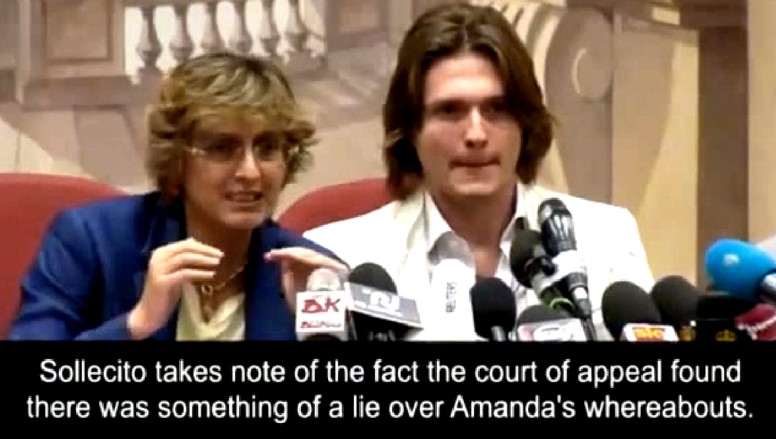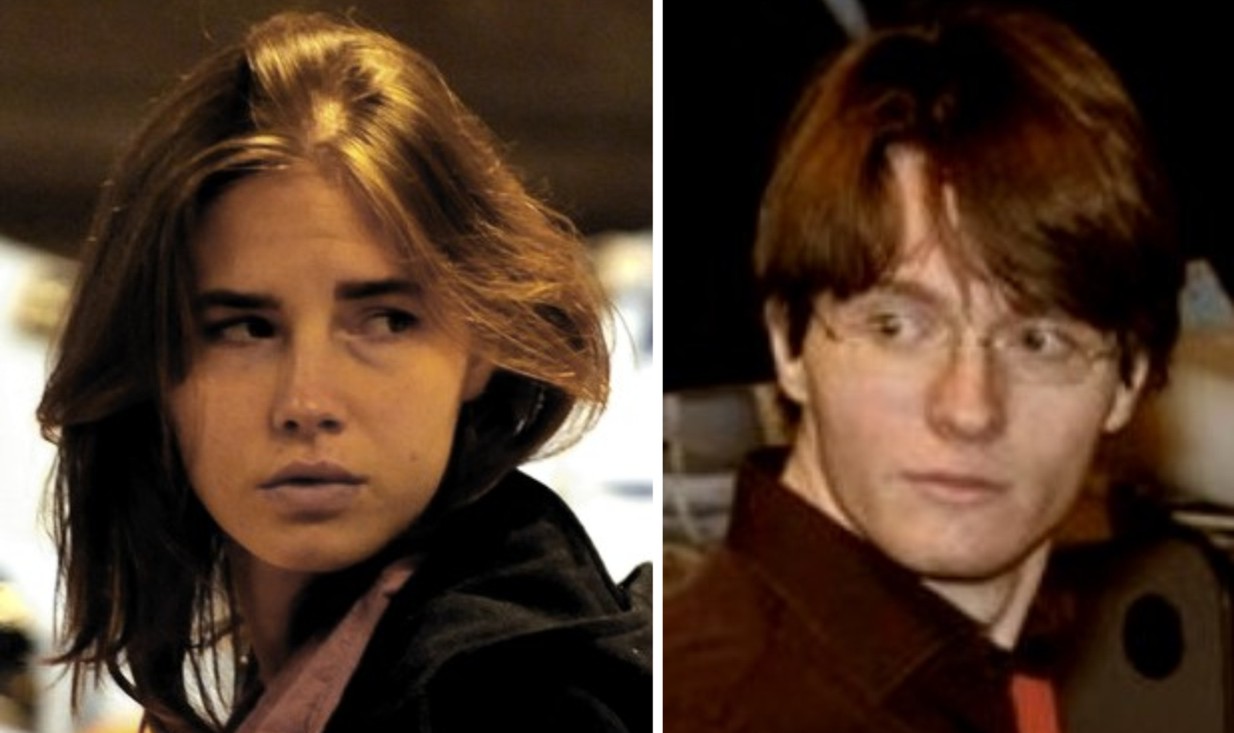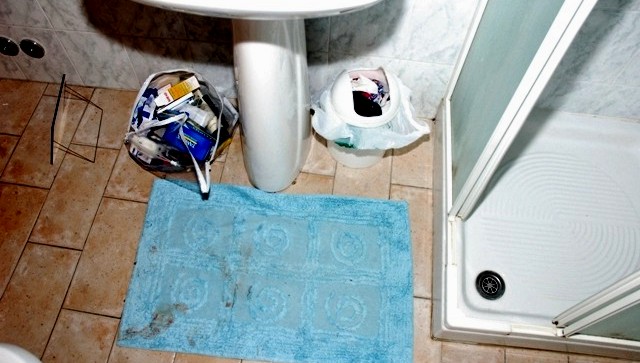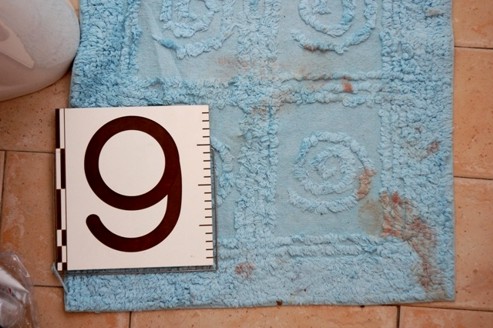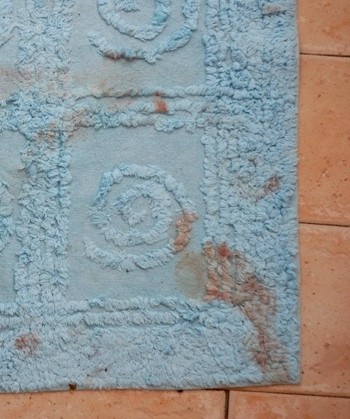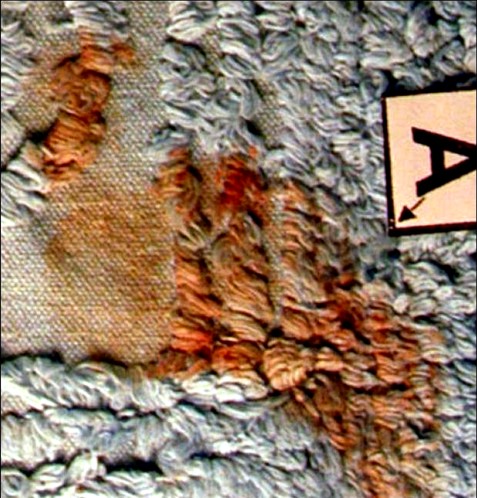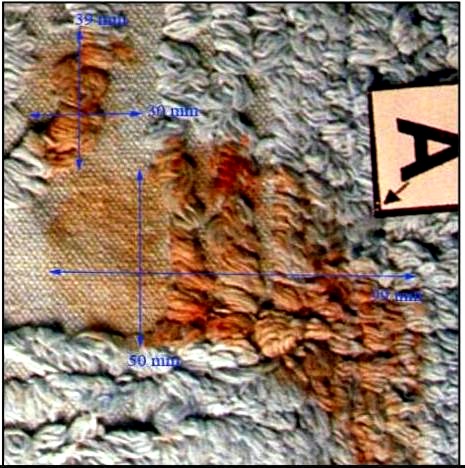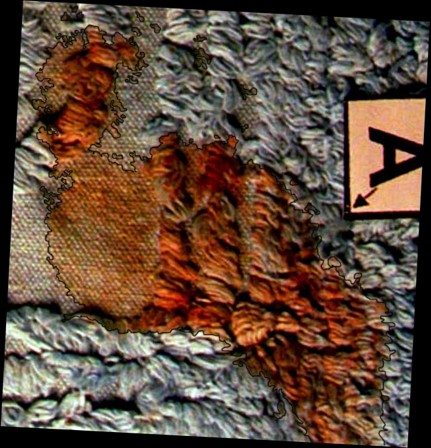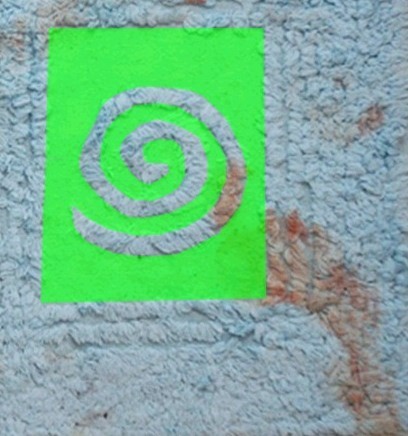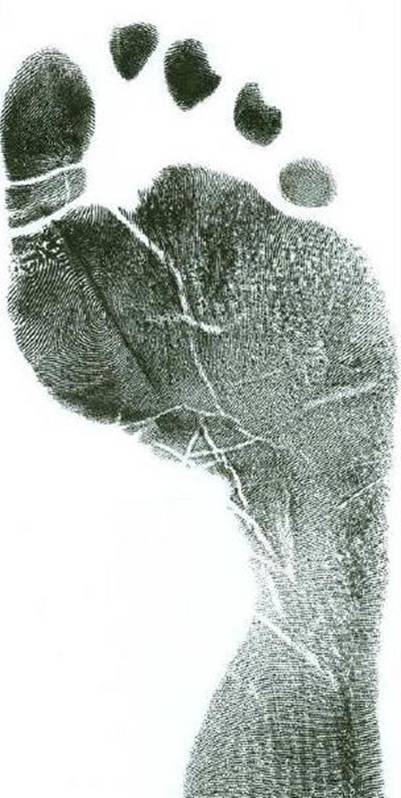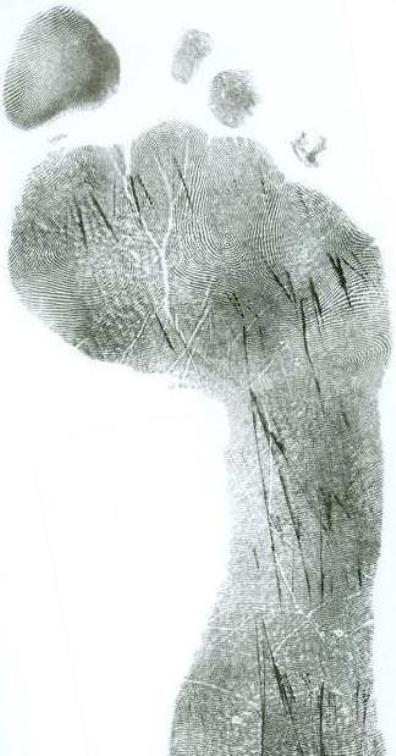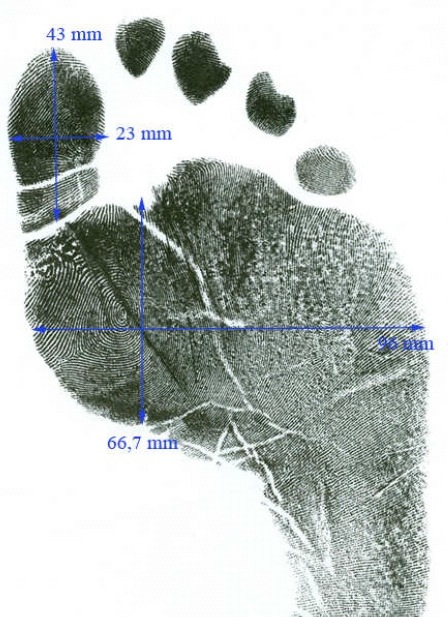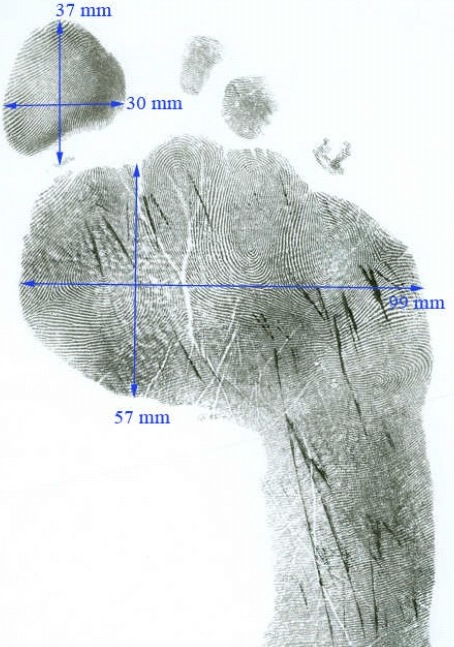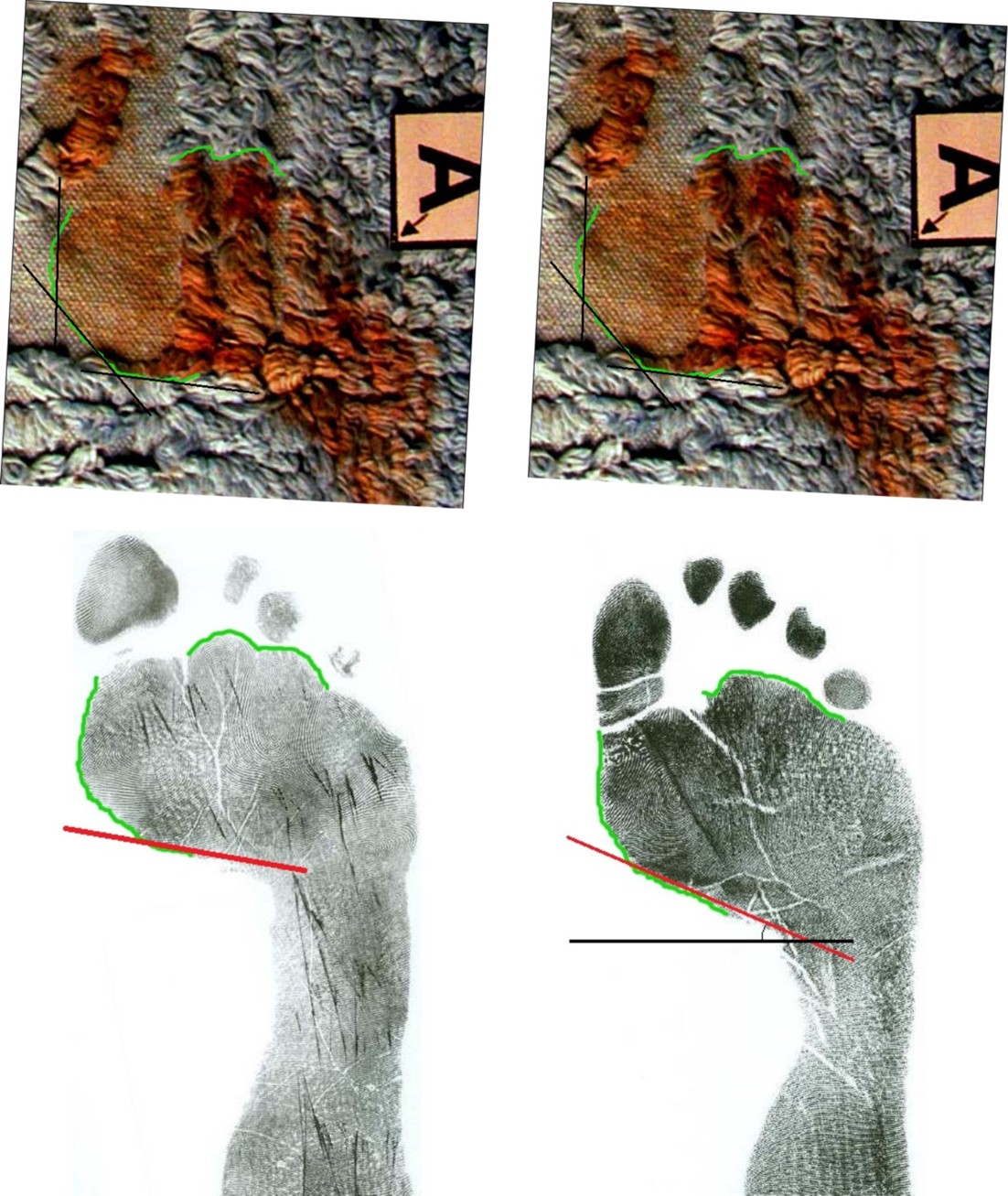
Category: 27 Single alibi hoax
Sunday, July 06, 2014
Spitting In the Wind: Sollecito News Conference Backfires On Him AND Knox - What The Media Missed
Posted by SomeAlibi
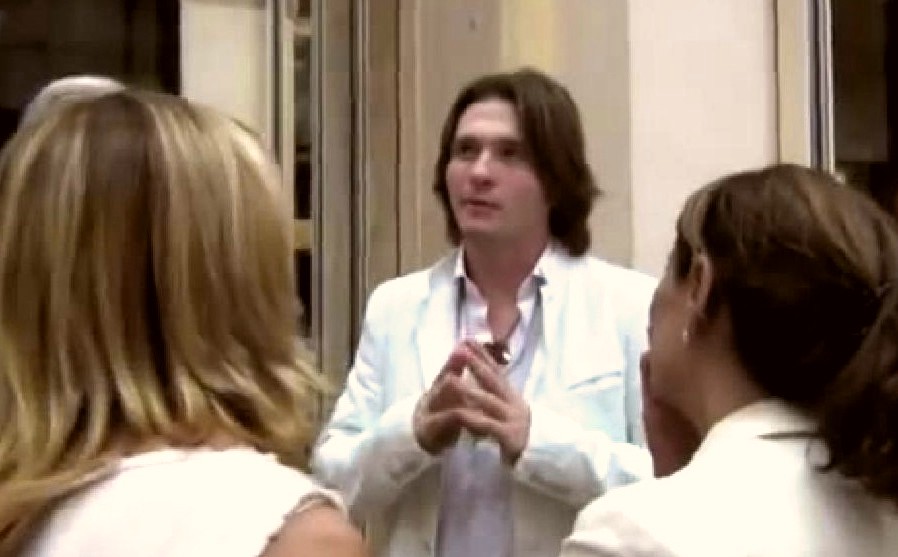
Raffaele looks for divine inspiration? Precious little showing at press conference on Tuesday
What on earth were they thinking?
At Tuesday morning’s press conference Raffaele Sollecito’s team did at least two completely inexplicable things.
Firstly, they scored a spectacular own-goal on the facts surrounding the murder of Meredith Kercher, which has been missed by the press.
Secondly, they did it all for no legal benefit.
In the run up to the press conference it was widely trailed that Sollecito would throw Amanda under the bus by removing her alibi - that she spent the whole of the night of the 1st of November with him at his apartment. After the press conference, it was widely reported he’d done that very thing.
Wrong. Very wrong. In fact, Team Sollecito did the opposite and put a position forward entirely consistent with how the prosecution says Knox, Sollecito and Guede all come together.
Speaking in tongues
There are only a few grains of sand left in the hourglass before Cassation and confirmation of the sentence, which will see Sollecito return to jail until he is well into his forties. You would have thought that it would be “absurd” for him to do anything other than speak clearly and unequivocally.
But that is precisely what didn’t happen…
Sollecito and lead counsel Giulia Bongiorno performed a bizarre tip-toe dance, avoiding saying anything clear or direct. Instead, they made points by reference and allusion, with an unhealthy assortment of metaphorical nods, winks, heavy coughs and adjustments of the lapels at key points.
Did Raffaele say that Amanda left his apartment in the early evening? No. As Bongiorno tortuously phrased it: “Raffaele takes note of the fact the court of appeal found there was something of a lie over Amanda’s whereabouts”¦ of the fact the court [says] she was not with him in the early evening”.
Takes note? What on earth was that all about? Well, the sentence mangling was because at the final Cassation hearing next year, no fresh facts can be heard. The only arguments that can be heard are on failure of due process or failure of logic and reasoning as pmf.org Italian legal expert Popper explains extremely clearly here:
I think we should clarify a number of points after discussions of past few days:
1) Corte di Cassazione does not hear evidence and can only discuss the possible invalidation of a sentence or part of it ref the points appealed, not other points. Corte di Cassazione does not hear defendants or private parties. In public hearings only a specific category of lawyers (Cassazionisti) can speak before them
2) Corte di Cassazione therefore cannot take into account evidence now given spontaneously by the defendant RS directed against AK (eg open door of Filomena) as in Court he has never accepted cross-interrogation of AK’s lawyers, except if on some points RS’ lawyers appealed in writing for manifest illogicality of reasoning but what he says now cannot be used. Keep in mind Cassazione cannot discuss the merit of the judgement of Nencini and Massei, only invalidate it if this judgement and reasoning were based on clearly illogical arguments or neglected key evidence
3) Only if Cassazione invalidated Nencini and remanded to a further appeal a possible renovation of “istruttoria” (evidence discussion) may take place. Otherwise all RS has to say now, even if he confesses she did it and he only helped clean [unlikely IMHO], cannot be taken into account by Corte di Cassazione and would have to be the possible argument for a “revisione del giudicato” (a case in which, after a final judgement, a convicted person claims there is a clear error and brings solid evidence to prove it, it is quite rare only in case of obvious errors. Procedure can be easily denied and IMHO will be denied if he said he just helped clean as Courts have already considered that scenario and rejected it)
4) any discussion on cocaine was not taken into account to convict (even if true, no evidence they sniffed that night) and will not be taken into account by Corte di Cassazione, in theory will not be taken into account for extradition hearing in US Court as this only verifies there is a conviction and treaty respected. PR is another matter, but I think it is not correct to say that would be added to extradition request and may change legal course. Same goes for garage video.
5) The press conference of RS was useless, the panel of Corte di Cassazione judges has not even been appointed and, while not illegal, it is completely unusual for a defendant to hold a PC talking about an appeal (RS is not a public figure or administrator). What counts is the appeal document that we have read. The “great” point that AK does not talk about RS in memoriale is too stupid for me to discuss it here. We must conclude this was only publicity for Bongiorno, she knows she is likely to lose and wishes to make it seem it is a close call. She has minimal chances, approximating 0%.
6) RS has very low chances to succeed, and LG for AK even less, as Corte di Cassazione explained well what they wanted and Nencini gave it to them. Court presided by AN explained who the people concurring with RG in the murder are and gave clear logical explanation for such conclusion. Also, Nencini confirmed first instance, a trial that was perfectly valid for Cassazione after first appeal was invalidated.
There have been cases of a double iteration at Cassazione eg in very complex terrorism trials, evidence was scarce mostly based on witnesses who wanted to sidetrack other investigations. Here, as Alan Dershowitz said [he does not know much about case but this and a few other points he got absolutely right] all pieces of evidence point exactly in the same direction creating a good case [AD does not know it is overwhelming; maybe he did not read all docs].
One other thing AD said, most FOA and JREF and IIP tend to forget: Court is the judge, not them, Court has the responsibility to evaluate all evidence and issue a judgement that, as long as explained logically and legally in writing [something a US jury would not be required to do] using all available elements, will stand and be final after Cassazione.
So, Team Sollecito needed to phrase all of their “points” as things already said by the Appeal Court, which are now facts in law unless overturned due to failure of logic etc.
From there they must then try and make insinuations about these “˜facts’, all the while dressing it up as if it were procedurally in accordance with the pre-Cassation phase. Even though “¦ and here one should be allowed a Pepto Bismol given all the twisting and turning”¦ as Popper explains, it will have no effect on the outcome whatsoever.
In the real world, it was quite clear that what Sollecito was actually saying was, “Yes, she did go out in the early part of the evening, even though I’m not personally saying it, those are the Court’s words.”
He left a massive hanging dot dot dot in place of: “˜Hey everyone - Amanda went off and performed the murder with Guede, not me! No, I haven’t stated the time of her return, because it’s not me talking, it’s the court, but she was out, so figure it out for yourselves”¦’
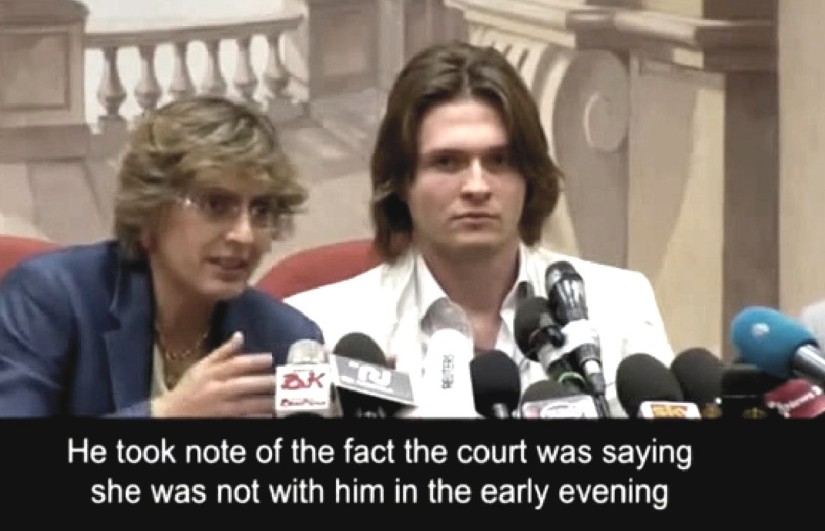
Not with him in the early evening, which is not the night, we are told, that begins around 11:00 pm
The light at the end of the tunnel has steam billowing underneath it
Here, Team Sollecito run into a horrendous brick-wall of facts which lays Raffaele and Knox out cold. It’s not hard to work it through, but the world’s weary press are too fatigued by this case to even do some simple “if-then” calculations and draw the appropriate conclusion.
So, let’s do it for them here”¦
- Team Sollecito are saying Knox went out before she sent her SMS reply to boss Patrick Lumumba at 8.35pm. This is in accordance with the case for the prosecution from day dot. They now agree, as the prosecution have always said, that Knox is out of Sollecito’s flat sometime before 8.35pm. (In fact, we know it’s by at least 8.17pm because this is when she received Lumumba’s text to say that she didn’t need to go into work).
- Team Sollecito then pause and wink to let you do the math(s). If the murder occurred circa 9.30pm by their estimate (which it didn’t, but let’s go with this for a second) and you don’t know when she returned to Sollecito’s for the night, then he couldn’t have done it, because he was at home, but she could.
Here, the Press stop and report Amanda is under the bus. Thank heavens for that, not a stain on Raffaele’s Warren Beatty white suit and can we all go home now?
Wrong. In fact, it’s a horrendous own-goal, which ricochets in hard off the testimony of both independent witness Jovana Popovic and Raffaele’s own father Francesco.
- At 8.40pm, Popovic arrives at the front door of Raffaele’s apartment and testifies that Amanda Knox opens the front door. It has been suggested that Popovic’s self-estimated timing of 8.40pm is wrong, but this rings very hollow indeed. Popovic had done the walk from her late class ending at 8.20pm many times, and knew it took 20 minutes because she lived on the same road ““ Corso Garibaldi ““ as Raffaele himself. Both Massei and Nencini agreed with this too. Ouch.
- So Knox, who was out previously, is already back, at least 50 minutes before even the putative time of murder put by the defence and a couple of hours plus before the real time.
- In fact, Raffaele’s father Francesco testified to the Massei court that he was certain that Amanda was with his son when he spoke to him at 8.52pm that night. And this was not contested by the defence. Double ouch.
So, even if Knox went out in the early evening, she is objectively shown to have been back at the apartment well before 9pm. And, if that is the case, both Knox and Sollecito are 100% back in the frame. And this is even before they are also seen by a third person who corroborates that they were together that night ““ Antonio Curatolo. Triple ouch.
Confirming how three became company
Worse yet, Knox has argued for 7 years that she never left the apartment. If Sollecito now “says” she did, but we know objectively that she is back at least by 8.40pm, it supports the prosecution case.
This was that Knox left for work and walked to near the cottage, in the area of the basketball court at Piazza Grimana, around where she received the text from Patrick saying not to come to work.
This is the exact time that Rudy Guede was having a kebab, only a couple of hundred yards away. This provides the opportunity for Knox and Guede to have seen each other. Knox, suddenly at a loose end, makes a plan, which involves asking for Guede’s help.
What might that help be? Well, the resurfacing story of Knox’s link with a cocaine dealer chimes nicely with the idea that Knox asked Rudy either to supply her or help her get some sort of drugs and that they arranged to meet back up once he had secured them.
Knox then returns to Raffaele’s to fetch him, is seen by Popovic and her presence acknowledged at 8.52pm by Papa Sollecito and son, before they both head out to connect with Guede back at Piazza Grimana. (Remember, this is where Knox “saw” Patrick Lumumba, when she tried to frame him).
Guede, as was his wont, managed to get himself invited back to the cottage, perhaps for a shared line. This is consistent with Knox’s prison piece “The Story of Marie Pace”, where there are at least two++ men present in a kitchen in a “party” type atmosphere taking drugs which ends up with a hospitalised victim.
It’s only one theory and there are others. However, what Team Sollecito managed to do this week was to confirm that Knox left the flat. Objective facts and witness testimony tell us the time by which she had returned.
And, in that round trip lies the entire timing, location and mechanism for how Guede became involved, which otherwise makes little sense. Now all confirmed by Team Sollecito…
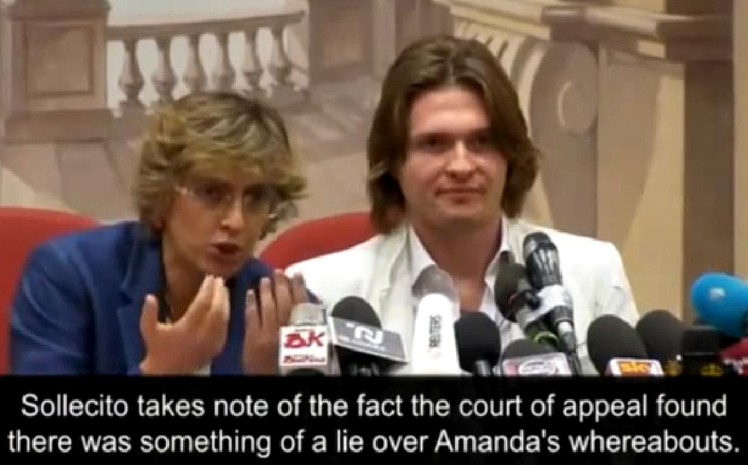
One of Raffaele Sollecito’s telling grimaces when Amanda Knox’s name is mentioned
What silence gets you
So what was the point? Face-saving for Raffaele? Hoping to key up populist support? Fat chance in Italy, where the case has been properly reported.
An opportunity to allude to a “truth” (the best one he can think of for now ““ other truths are available) and say that he and his family believe Knox is innocent? Pull the other one Raffaele!
It is quite clear that several members of the Sollecito clan think that Knox absolutely is guilty and their Raffaele is still too “honourable” to tell the truth. He merely aided the clean-up perhaps. Well in that case, why hasn’t he said exactly when she came back? Was it 11pm? 1am? Was it at 5am when the music starts playing. Why won’t he or you say?
Or”¦ was it face-saving for Bongiorno, as she faces defeat and seeks to protect her valued public persona? Well, as much as I’ve tried, I have no idea what they thought they were doing.
And to be honest with you, I honestly don’t think they were entirely sure, nor did they think through the consequences of the brick wall objectivity of Popovic + Papa Sollecito.
In the meantime, a family sits in Surrey listening and watching the weasel words and once again is insulted by this “honourable” all-in-white character who knows what “Amanda Marie Knox” did that night, but simply will not say.
Which of course he could choose to do at any moment, court proceedings or not, the way us normal human beings do it: not making allusion, not tipping a wink, but speaking the truth.
But he hasn’t and I suspect he won’t, even though it actually would now be the only thing that could mitigate the length of his inevitable prison term.
And for his acts and that silence he still won’t break - and at least here it is possible to finally speak with certainty - I believe he deserves every one of those 25 years.
Friday, July 04, 2014
The Status Of The Various Computers In The Case And Whether Anything Nefarious Happened To Them
Posted by Sallyoo
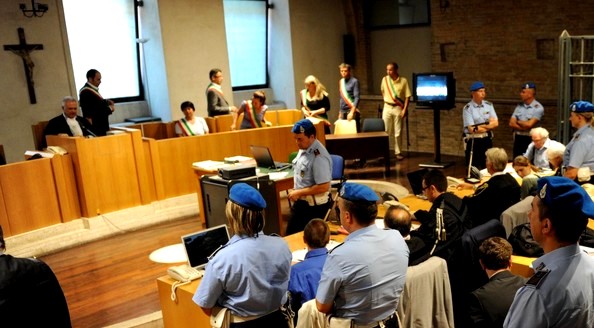
Trial court 2009 on one of several days computer and internet activity was testified to
1. Computer use as high-stakes evidence
There have been many arguments about computers during the case.
They began at the very beginning, and there is even now, in the final appeal by Sollecito to the Court of Cassazione, one remaining somewhat fantastical theory.
The facts surrounding the computer evidence collected by the prosecution have been obfuscated and contradicted by the defence using exactly the same techniques as have been used about the DNA and other forensic evidence in the case.
Blind the court (and the public) with hypotheses which very few people can follow, and use this ignorance to spread confusion and doubt.
Let’s try to shed some light.
2. Five key computers, plus
We know that Sollecito is pretty familiar with computers, he had two at the time, a MacBook and an Asus [1], both portables.[2] His apartment had a decent broadband connection, supplied, (using the Telecom Italia infrastructure) by Fastweb.
We know that both of these computers were sequestered from his apartment on the morning of Nov 6 2007, when Sollecito accompanied a squad of policemen despatched to search his apartment.
We know that the police removed, (on Nov 7), from the house in Via Della Pergola (where there was no telephone nor broadband service) a MacBook belonging to Meredith, a Toshiba belonging to Knox, and a portable computer belonging to Laura Mezzetti.
The police also took an HP portable from Lumumba’s apartment.
There is even another computer which the police already had possession of, and that is a Sony portable belonging to Filomena Romanelli. This computer Filomena herself had taken away from her bedroom shortly after the discovery of the murder, and which the questura, in the evening of Nov 2, required her to hand over to them because it formed part of the ‘crime scene’.
3. The police HD analysis begins
On Nov 13 a postal police technician (Marco Trotta) received a box containing five computers (two from Sollecito, Knox, Meredith and Lumumba).
On Nov 15, in the presence of Formenti, (a consultant nominated by the defence) Trotta took them apart (removed the hard disks) and attempted to make copies of the data recorded on them.
This is the point at which it is alleged the destruction of three hard disks occurred.
It is difficult to believe that this is the case. Not only because the equipment used had never before (or since) managed to trash a hard disk (and it had no problems with Lumumba’s disk) but also because of the state of Filomena’s computer, which never got anywhere near Trotta.
All of the computers had of course been in the hands of the squadra mobile for some days before being consigned to Trotta, allowing for the possibility of some earlier interference by some malfeasant policeman.
This isn’t likely, not only because Trotta insists that the computers were complete and superficially undamaged, and the hard disks factory sealed when he dismantled the computers, but also because of Filomena’s computer.
4. Filomena’s Sony machine
It is now time to go a little deeper into the history of Filomena’s Sony.
This was a fairly new machine, which she kept in a substantial computer carrying case. It was working perfectly on Oct 30 when she last used it. She had left it in her bedroom, the case standing upright beside her bed, when she went off to spend the brief holiday with her boyfriend.
She found it, still in the carrying case, lying flat in a pile of stuff under the broken window of her disturbed bedroom. [3]
The defence commissioned a Computer Expert Report, entered during the Massei trial, which talked about the reason for the data being irrecoverable on the three computers’ disks.
Their conclusion was that the electronic circuitry controlling the hard disks had, in all three cases, suffered damage, most probably due to an electrical overtension. The circuitry had been ‘fried’.
They were unable to be certain how or when this might have occurred, or to opine on whether it was deliberate.
Filomena, in the presence of Gregori, (another communications police officer), at the Questura on the evening of Nov 2 attempted to turn on her Sony. It wouldn’t work. The hard disk would not respond properly.
When she got it back on Dec 18 and gave it to a private computer technician, he said the control circuitry on the hard disk is ‘fried’. Exactly the same fault as had occurred on the other three, which we are expected by th defense to believe was either a deliberate piece of police sabotage, or proof of police incompetence.
5. The Sollecito computers
The important computers, of course, are those owned by Sollecito because he is, even now, still trying to force an alibi out of them.
The MacBook has been accurately interrogated to death, most particularly by a defence expert named Antonio d’Ambrosio who gave very clear testimony at Massei on 26 Sept 2009.
He was even generous enough to acknowledge that the investigations carried out by the postal police were correct, and well interpreted, and that he was able to uncover a little more information simply because he wasn’t limited by forensic protocols (and could therefore reveal information not visible to the Encase software used by the police) when he examined a copy of the cloned disk from the Mac.
Basically the only ‘news’ in this interesting testimony was an interaction with the Apple website at 00.58 on Nov 2, which he did consider a human interaction with the computer.
6. Activity on the Internet
Sollecito maintains he spent the whole evening and night in his flat. At first his story was that he was sending e-mails and surfing the web. This was quickly demolished by reference to the IP log supplied by Fastweb, the broadband supplier.
It’s necessary to get slightly technical here.
Most of what we call The Internet, and certainly everything which is called The Worldwide Web, including e-mail clients, subscribe to a protocol which (in shorthand) means everything is a Port 80 request.
The individual computer, via its router, contacts the ISP (Fastweb, in this case) and identifies itself by means of a unique IP address. The ISP then directs the communication to the IP of the website requested.
This is all recorded on the Fastweb network. It is certain that no Port 80 requests were made from Sollecito’s apartment (whichever computer he may have been using) between 18.00 on Nov 1 and 00.58 on Nov 2.
There are parts of the international communications network which don’t use Port 80 protocols. The most ‘innocent’ of these are Peer to Peer (P2P) networks ““ in widespread use for distributing and downloading music and video files.
Sollecito certainly availed himself of these services, using a program called Amule on his Mac. He had a folder containing downloaded files, which was accessible to the program, and thus also accessible to anyone in the world who wanted a copy of something which Sollecito had in this shareable folder on his computer.
If he wished to save the file for posterity, he would move or copy it from this accessible folder into his own archive.
Video files are large, and they take a long time to download. Clearly, to download a file, or to make your publicly accessible folder available, the computer has to be turned on and connected to a router.
If you use these file sharing services extensively, it implies that you keep your computer turned on and connected all the time. It seems likely that this was Sollecito’s habit.
Clearly, you need to automate this sort of transfer ““ often a large file will be accessed in part from one remote computer, and another part will be located on another remote computer ““ so you simply instruct Amule to get you a film, or a list of films, and you can walk away from the computer.
Even D’Ambrosio is unable to be certain that a human interaction occurred at 21.26 on Nov 1, or whether a pre-requested download of Naruto commenced.
However, no IP addresses are exchanged when connecting to a P2P network, and so it is impossible (from ISP records) to trace any traffic.
It is possible though, from the hard disk, to discover what has been downloaded and saved to a computer on a P2P network, and exactly when ““ but to distinguish an automated process from a user instigated one is not possible.
7. Computers and Hellmann appeal
Now we move onto the Hellmann appeal, where a report from this same consultant D’Ambrosio was accepted into the case files. I haven’t been able to find this report, and Judge Hellman doesn’t even refer to it in his sentencing report.
However, the gist of this D’Ambrosio report is included in the current ricorso (appeal) from Sollecito to the Court of Cassazione.
8. Computers and Cassation appeal
We hear a bit about screensaver behaviour, and quite a lot about post Nov 1 interactions overwriting earlier actions.
The major ‘fresh’ theory now depends on asserting (more than four times in the ricorso) that the postal police destroyed Sollecito’s Asus, and that this action has meant that Sollecito’s alibi cannot be proved.
The lack of any signs of interaction on the Mac can be explained (so we are informed) by the Mac and the Asus being networked together, using a file sharing utility named Samba, and if the (broken) Asus could have been accessed it might have shown that it had been controlling the Mac.
So the Mac would have been doing things at the command of its owner, but because the owner was interacting with the keyboard of the Asus rather than that of the Mac, these actions are undetectable on the Mac.
This is what we are now being asked to believe.
9. Conclusion and way forward
I think this is an accurate summary of the relevant parts of ‘computer evidence’ discussed, or deposited, during the hearings and in the ricorso. I look forward to any comments, clarifications, corrections, but above all, to any new theories about how and when the four hard disks got trashed.
From other sources there are an additional two hints at possible new or ignored evidence:
The BBC reported, on 14.03.2009, the following sentence. “A second computer belonging to Mr Sollecito also showed no activity but the suspect had himself admitted it had been broken before the crime was committed.” [4]
And then we have Sollecito, in his prison diary of 11.11.2007, being rather more than aware that his computer is not going to be useful to him as an alibi.
I have been very anxious and nervous in the last few days, but to see my father who tells me “do not worry, we will get you out” makes me feel better. My real concerns are now two: the first one derives from the fact that, if that night Amanda remained with me all night long, we could have (and this is a very remote possibility) made love all evening and night only stopping to eat… it would be a real problem [casino] because there would be no connections from my computer to servers in those hours…
No connections in those hours? Hmmm.
10. My references
[1] This computer is sometimes referenced as an Acer. In Trotta’s testimony (he is reading from notes) it is listed as an Asus, so I have used this name. There is only one computer whether it’s an Asus or an Acer.
[2] There is a reference to a non portable computer in Sollecito’s apartment (in the testimony of Popovic). This is the only mention of any non-portable (i.e. desktop or tower cased machine with separate monitor). Given the position from which Popovic saw the screen (on a desk, with Knox sitting in front of it) it seems likely that she was mistaken.
[3] Amanda Knox frequently refers to seeing Filomena’s computer on her desk after the ‘break in’. At one point in her testimony she changes her mind and corrects herself to change the computer to camera.
[4] http://news.bbc.co.uk/2/hi/uk_news/7943828.stm I have not found another source for this comment.
Wednesday, July 02, 2014
Rome Press Conference Reports: Sollecito Separates From Knox, Bongiorno Misleads On Her Text
Posted by Our Main Posters
1. Overview Of This Post
Sollecito and Bongiorno held a much-attended press conference at which they tried to hang Knox out to dry.
This post first quotes some of the reports and then looks at the big reveal, that there is proof Knox was out TWICE including later in the evening when Sollecito was still at home.
2. Reports From English-Language Media
Raffaele Sollecito, the ex-boyfriend of Amanda Knox who faces a 25-year prison sentence for the murder of Meredith Kercher, has placed renewed pressure on his American co-defendant by noting “certain anomalies” in her case.
As he unveiled his defence strategy for a potentially definitive appeal which could see him and Knox definitively convicted of the British student’s killing in 2007, the 30-year-old Italian said he still believed “to this day in the innocence of Amanda Marie Knox”.
But, in what some read as a sign he is preparing to distance himself from his former lover after six-and-a-half years of rigidly joint defence, he added: “But obviously, in what I read in the court papers, I register certain anomalies.”
While saying she hoped both convictions would be quashed by Italy’s supreme court, Sollecito’s lawyer, Giulia Bongiorno, urged the judges to take “coherent and consequent decisions” if they felt there were contradictions in the appeal court’s sentence, and not to “automatically extend anomalies pertaining to Amanda to Sollecito”.
At a press conference in Rome on Tuesday, Sollecito acknowledged, as he has done previously, that he cannot be absolutely certain of how much time the 27-year-old student from Seattle spent in his flat on the early part of the evening of the murder, even if he is certain the two spent the night together. The pair have always said their memories were foggy due to the effects of cannabis.
Sollecito’s appeal, said Bongiorno, focused on a text message which Knox says she sent from her then boyfriend’s home at 8.35pm the evening of the murder but which the Florence court, in its reasoning, accepts was sent from outside.
“According to the sentence, this [SMS] was not written from Raffaele’s house. Therefore the two were not together,” said Bongiorno. She added that, from her client’s point of view, the discrepancy was “either the nth mistake of the sentence, or ‘I [Sollecito] was lied to, too.’”
She added that his defence team had estimated that the attack on Kercher took place between 9pm and 9.30pm ““ though a time of death has never been agreed on and prosecutors have argued it occurred later. Sollecito says evidence from his computer proves he was at his home until at least 9.26pm.
Another hinge of his defence is a memo written by Knox in which she admitted to confusion over earlier statements in which she had falsely accused bar owner Patrick Lumumba of the murder, said she was present at her house and heard the 21-year-old Leeds University student “screaming”.
She later retracted the statements.
Sollecito said he did not believe the contents of the “odd, eccentric” memo, but that as the Florence appeals court ““ which reinstated the pair’s guilty verdicts in January ““ appeared to draw on parts of it for the convictions, he was forced to respond to that version of events.
“For me this memo recounts only fantasies and figments of the imagination,” he said. “But if what were written in the memo were true, taking it as a given that the judges are right [to use it in their verdict], could you explain to me where I figure in it?”
He added: “What is my participation? What is my motive, my involvement, anything? Explain it to me, because my name is Raffaele Sollecito and not Amanda Marie Knox.”
At a press conference in Rome on Tuesday, Sollecito insisted that he was innocent but said he remained convinced that Knox was too.
Unveiling his new defence strategy, he said January’s guilty verdict had been based on evidence from Knox that exonerated him.
“The 25-year prison sentence given to me is based entirely on the statement written by Amanda Knox in pre-trial detention. She herself exonerates me entirely,” he told press.
In the statement, she says she was in her flat while the murder was being committed, “with my hands over my ears because in my head I could hear Meredith screaming”.
Sollecito is not mentioned by Knox in the text, which his defence team says is proof he was not present at the scene.
“Taking it as read that the judges are right [in basing their verdict on Knox’s statement] will you please explain what I have to do with it?” Sollecito said.
Knox later withdrew the statement after saying she had written it under police pressure, and the pair have been each other’s alibis since, saying they spent the night together at his house.
Sollecito’s lawyer Giulia Bongiorno said that while he has always said he “spent the night” with Knox, he has never said they spent the evening together.
Ms Bongiorno added that her client’s appeal would cite a text message that Knox claims to have sent while with Sollecito at his house.
“This text message, according to the court’s own ruling, was not sent from his house. Therefore the pair were not together,” she said.
Despite throwing doubt on his ex-girlfriend’s alibi, the Italian said he had “always believed, and still believe, that Amanda Marie Knox is innocent.”
Knox and Sollecito have always maintained that they were together the evening of the brutal 2007 murder in Perugia, after which Miss Kercher, 21, was found half naked her throat slit in the cottage she shared with Knox.
But Sollecito’s lawyer Giulia Bongiorno said that ‘for the entire first part of the evening, they were not together. It’s this first part of the evening that’s new [to his defence]’.
Sollecito has pointed to phone records that show that Knox was away from his house for part of the evening.
In a dramatic change of legal tactics that he announced in a press conference in Rome he has now claimed there are “˜anomalies’ in Knox’s story.
Knox says that she received a text, while at Sollecito’s house, from her boss, telling her not to come to her job at a nightclub that night.
But phone records show that the text was received on the road between their houses, something that their retrial judges felt was key in their reconstruction of events. Sollecito’s phone and computer records show that he was at home that evening.
Sollecito said: “˜I have always believed in the innocence of Amanda. But I have to react to the accusations of the court and to the text message.
“˜Either the court has made their umpteenth mistake or she lied to me.’
He added: “˜I was in love with her and we had some very happy moments, but ultimately Amanda was a stranger.’
‘There are anomalies in her version of events. Against me there is nothing.’
The ‘fundamental basis’ for the conviction is Knox’s memo to police in which she says she was at the cottage when the murder took place, he said.
“˜I believe this was a hallucination, but if the court believes it is true then they have to accept that she did not say I was there. She gave me an alibi. “˜
It is not the first time Sollecito has expressed his doubts about the holes in Knox’s story.
In an interview with Italian television earlier this year, he said Knox had spent the night with him but went back to her place to shower, he said. When she returned, she was ‘very agitated,’ he said.
She told him that it looked like someone had broken in and that there was blood in the bathroom, Sollecito said. But rather than call the police, she showered and returned to his place something he finds odd. “˜Certainly I asked her questions,’ he said. ‘Why did you take a shower? Why did she spend so much time there?’
He didn’t get any real answers from her, he said.
3. Analysis: Bongiorno’s Claim About Knox’s Location When Texting
Giulia Bongiorno claimed yesterday that Amanda Knox replied to Patrick’s text while she was away from Sollecito’s house.
This is demonstrably untrue.
Mobile-phone-tower records show that Knox’s phone received Patrick’s incoming text telling her not to come to work when she was already somewhere on the route to his bar in Via Alessi. Knox apparently then turned around and went back to Sollecito’s house.
Mobile-phone-tower records show Knox texted back, responding to Patrick, from Sollecito’s house in Corso Garibaldi at 8:35.
They both claim this in their books - Sollecito himself claims it too. Those books are pretty suspect throughout, but for once they both tell the same truth.
Some five minutes later, Knox and Ms Popovic met at Sollecito’s house so Knox was still there then. That is still three to four hours away from the best estimate of Meredith’s death.
So the time-period prior to 8:35 pm when Knox texted from Sollecito’s flat was the only time-period when there is hard proof that Knox and Sollecito were ever apart that night. In her unforced statements on 5-6 November Knox did claim she went out alone to see Patrick, but we have only her word she was alone.
Here is the narrative from Judge Massei’s 2009 report.
− 20:18:12: Amanda receives the SMS sent to her by Patrick Lumumba, which let her off from having to go to work at the “šLe Chic”› pub on the evening of 1 November. At the time of reception the phone connected to the cell on Via dell’Aquila 5-Torre dell’Acquedotto sector 3, whose signal does not reach Raffaele Sollecito’s house. The young woman was therefore far [i.e. absent] from Corso Garibaldi 30 when the SMS reached her, as she was walking in an area which was shown to be served by the Via dell’Aquila 5-Torre dell’Acquedotto sector 3 cell. This point of her route could correspond to Via U. Rocchi, to Piazza Cavallotti, to Piazza IV Novembre, bearing in mind that Lumumba’s pub is located in Via Alessi, and that Amanda Knox would have had to travel along the above-mentioned roads and the piazza in order to reach the pub
− 20.35.48 Amanda sent an SMS in reply to Patrick, at No. 338-7195723; the message was sent when the young woman’s mobile phone was in Corso Garibaldi 30 or in the immediate neighbourhood. The cell used, in fact, was that of Via Berardi sector 7.
Here is the narrative from Judge Nencini’s 2014 report.
At 20.18 and 12 seconds, Amanda Marie Knox received a text message sent to her by Patrick Lumumba, in which he informed her that it would not be necessary for her to go to the bar to carry out her usual work. At the time of receipt, Amanda Marie Knox’s handset connected via the sector 3 mast at Torre dell’Acquedotto, 5 dell’Aquila, as shown by phone records entered in evidence. This mast cannot be reached from the vicinity of 130 Via Garibaldi, the home of Raffaele Sollecito. According to the findings of the judicial police entered in evidence, this mast could be reached by anyone in Via Rocchi, piazza Cavallotti or piazza 4 Novembre, all locations in Perugia which are intermediate between 130 Via Garibaldi, the home of Raffaele Sollecito, and Via Alessi, where the “Le Chic” bar is located.
From this set of facts established in the case, Amanda Marie Knox’s claim, according to which she received Patrick Lumumba’s text message while she was at 130 Via Garibaldi, appears false. Given the mast connected to and the time, it is reasonable to assume that, when Amanda received the message, she had already left Raffaele Sollecito’s home and was on her way to the “Le Chic” bar. Presumably, she then turned around and went back.
Here, then, is the first crack in the account of the young woman who, in her narrative, claims never to have left the house at 130 Via Garibaldi from the moment of her entrance into the house in the afternoon of 1 November 2007, together with Raffaele Sollecito. There is oral evidence (the deposition of Popovic) and evidence obtained through phone records that, at around 18:00 on 1 November 2007, Amanda and Raffaele were at the home of the latter. Later, at precisely 20:35 and 48 seconds, when Amanda Marie Knox sent a text message to Patrick Lumumba, connecting to a mast serving 130 Via Garibaldi, both were once again [118]together at Raffaele Sollecito’s home. This fact is confirmed by Popovic, who went there to cancel that evening’s appointment with Raffaele. In fact, the witness reported that she had visited Raffaele’s home at around 20:40 in the evening.
In essence, it can be established with certainty that Amanda and Raffaele were apart, albeit for a limited period of time, on the evening of 1 November 2007, contrary to what is stated repeatedly in multiple statements made by Amanda Marie Knox.
It seems Bongiorno got it wrong about Knox, and Sollecito sat beside her happily nodding his okay.
Amanda Knox Left Sollecito’s House By Herself? Both Claimed It But Neither Of Their Books Back It Up
Posted by Our Main Posters
1. Current Contexts Of Sollecito’s And Knox’s Books
Neither book is exactly riddled with truths.
The claims throughout Sollecito’s book are soon to be the subject of a trial in Florence and the claims throughout Knox’s book are soon to be the subject of a trial in Bergamo. So both will need to endorse or reject what they wrote.
Plus Knox will need to endorse or reject this, from the first unforced statement she insisted on making without a lawyer on 6 November 2007. This is what Sollecito is gleefully using against her now.
Last Thursday, November 1, a day on which I normally work, while I was at the house of my boyfriend Raffaele, at around 8:30 pm, I received a message on my cellular phone from Patrik, who told me that the premises would remain closed that evening, because there were no customers, and thus I would not need to go to work.
I responded to the message by telling him that we would see each other at once; I then left the house, telling my boyfriend that I had to go to work. In view of the fact that during the afternoon I had smoked a joint, I felt confused, since I do not frequently make use of mind-altering substances, nor of heavier substances.
I met Patrik immediately afterward, at the basketball court on Piazza Grimana, and together we went [to my] home.
2. From Sollecito’s Honor Bound (Simon & Schuster 2012)
Amanda and I smoked a joint before leaving the house on Via della Pergola, wandered into town for some shopping before remembering we had enough for dinner already, and headed back to my place. Shortly before six, a Serbian friend of mine named Jovana Popovic rang the doorbell and asked if I’d mind driving her to the bus station at midnight to pick up a suitcase her mother was sending. I said that would be fine. When she left, Amanda and I sat down at the computer to watch a favorite movie, Amélie.
We had to stop the film a few times as the evening wore on. First, Amanda got a text from Patrick telling her it was a slow night because of the holiday and he didn’t need her to come in after all. It was like getting an unexpected snow day””we were thrilled. Amanda texted back: Certo ci vediamo più tardi buona serata! Sure. See you later. Have a good evening.
Then my father called. He and Mara had just seen the Will Smith movie The Pursuit of Happyness, and he told me how beautifully it portrayed the relationship between a father and his son. My father was always making phone calls like this. It was sweet that he wanted to share his experiences, but he also made everything he said sound vaguely like an order, as if laying out the parameters of how I should react to things before I’d had a chance to form my own opinion. But he never stayed on the line for long””he is too nervy and impatient””so I listened calmly and the call was over in less than four minutes.
In the meantime, Jovana dropped by again and told Amanda that I didn’t need to drive her to the bus station after all. Now we didn’t have to leave the apartment. The evening was ours, and we couldn’t have been happier. We switched off our cell phones, finished watching Amélie, and discussed what to make for dinner…
When Amélie ended, I went into the kitchen to take care of some dishes left over from breakfast before we started making dinner. I soon realized that water was leaking out of the pipe under the sink, and I cursed under my breath. I’d had a plumber come and fix the sink just a week earlier, and he had made me buy all sorts of replacement parts that clearly were not put together properly. I suspected he had left them loose on purpose to force me to pay for another visit. As Amanda and I threw kitchen towels onto the puddle on the tile floor, I decided I was going to let my landlady deal with it from now on.
“Don’t you have a mop?” Amanda asked. I did not. She offered to pick one up from Via della Pergola the next morning and bring it round.
We cooked a fish dinner, did our best to wash the dishes again, and tumbled gratefully into bed in each other’s arms. Only later, when I lay in the dark, unable to sleep, did it dawn on me that Papà had broken his usual habit of calling to wish me good night.
It turned out he did so out of consideration. He had been about to pick up the phone when my stepmother talked him out of it. “Stop bothering him,” Mara said, as they got ready for bed around eleven o’clock. “He’s with Amanda, and they want to be alone. Why don’t you send a text instead?”
My father took her advice, but because my cell phone was turned off, I didn’t receive the message until six the next morning.
It was a desperately unlucky combination of circumstances. If my father had tried my cell and then called me on the home line””which he would have done, because he’s persistent that way””I would have had incontrovertible proof from the phone records that I was home that night. And the nightmare that was about to engulf me might never have begun.
My father called my landline a little before nine thirty the next morning to make sure we would be ready for our day trip to Gubbio. I was too groggy to talk. I’d been up several times in the night””listening to music, answering e-mail, making love””and wanted only to go back to sleep. Amanda got out of bed and said she was going home to shower and change her clothes, so I walked her to the front door, gave her a kiss, and crawled back under the covers.
3. From Knox’s Waiting To Be Heard (HarperCollins 2013)
Raffaele and I were good at being low-key together. We chilled out in the common room and smoked a joint while I played Beatles songs on the guitar for an hour or so. Sometime between 4 P.M. and 5 P.M., we left to go to his place. We wanted a quiet, cozy night in. As we walked along, I was telling Raffaele that Amélie was my all-time favorite movie.
“Really?” he asked. “I’ve never seen it.”
“Oh my God,” I said, unbelieving. “You have to see it right this second! You’ll love it!”
Not long after we got back to Raffaele’s, his doorbell rang. It was a friend of his whom I’d never met””a pretty, put-together medical student named Jovanna Popovic, who spoke Italian so quickly I couldn’t understand her. She’d come to ask Raffaele for a favor. Her mother was putting a suitcase on a bus for her and she wondered if he could drive her to the station at midnight to pick it up.
“Sure,” Raffaele said.
As soon as she left, we downloaded the movie on his computer and sat on his bed to watch it. Around 8:30 P.M. I suddenly remembered that it was Thursday, one of my regular workdays. Quickly checking my phone, I saw that Patrick had sent me a text telling me I didn’t have to come in. Since it was a holiday, he thought it would be a slow night.
“Okay,” I texted back. “Ci vediamo più tardi buona serata!”””“See you later. Have a good evening!” Then I turned off my phone, just in case he changed his mind and wanted me to come in after all. I was so excited to have the night off that I jumped on top of Raffaele, cheering, “Woo-hoo! Woo-hoo!”
Our good mood was only elevated when the doorbell rang again at 8:45 P.M: Jovanna had come back, this time to say that the suitcase hadn’t made the bus and that she didn’t need a ride after all. With no more obligations, we had the whole rest of the night just to be with each other and chill out.
After the movie ended, around 9:15 P.M., we sautéed a piece of fish and made a simple salad. We were washing the dishes when we realized that the kitchen sink was leaking. Raffaele, who’d already had a plumber come once, was frustrated and frantically tried to mop up a lot of water with a little rag. He ended up leaving a puddle.
“I’ll bring the mop over from our house tomorrow. No big deal,” I said.
Raffaele sat down at his desk and rolled a joint, and I climbed into his lap to read aloud to him from another Harry Potter book, this one in German. I translated the parts he didn’t understand, as best I could, into Italian or English while we smoked and giggled.
Later, when we were in bed, our conversation wound its way to his mother. His dad had divorced her years before, but she’d never gotten over the break. In 2005 she had died suddenly. “Some ¬people suspect she killed herself, but I’m positive she didn’t,” Raffaele said. “She would never do that. She had a bad heart, and it just gave out. It was horrible for me””¬we were really close””¬and I miss her all the time.”
I felt terrible for him, but it was hard for me to relate. The only person I knew who had died was my grandfather, when I was sixteen. I felt sad when my mom told me, but my grandfather had been old and sick, and we had expected his death for a few weeks.
I’m sure Mom and Oma must have cried, but my strongest memory is sitting around the dining room table telling funny stories about Opa. My grandmother’s message””that grieving was something you did in private; that you didn’t make public displays and you kept on moving forward””had remained with me.
Hearing the pain in Raffaele’s voice, I hurt for him. Nestling my head on his chest, I tried to be comforting.
As we started kissing, Raffaele gave me a hickey on my neck. We undressed the rest of the way, had sex, and fell asleep.
We’d known each other for exactly one week and had settled so quickly into an easy routine that one night seemed to melt happily and indistinguishably into the one that came after.
We planned to break our routine the next day, All Souls’ Day, by taking a long drive into the countryside, to the neighboring town of Gubbio. The November 2 holiday wasn’t usually observed with as much fanfare as All Saints’ Day, but since it fell on a Friday in 2007, a lot of people, including us, were turning it into a four-day weekend. I thought, Italians having a good time again. And I couldn’t wait.
Saturday, June 28, 2014
Sollecito Suddenly Remembers He Wasnt There But Cannot Speak For Knox Who (As She Said) Went Out
Posted by Peter Quennell
1. The State Of Play
Sollecito is becoming intent again on digging himself out (really). But he and his own team have created definite problems.
Consider for example the last two public performances by Raffaele Sollecito’s defense, both in Florence. They consisted of:
- 1. Giulia Bongiorno in her summation back in January, in Florence, at the tail-end of RS’s and AK’s appeal, ranting on foolishly about Perugia and Rome justice officials, in an apparent attempt to outdo even the nastiness of Amanda Knox’s earlier email to Judge Nencini which also ranted on foolishly about those officials.
2. Giulia Bongiorno fooishly taking strong offense to Judge Nencini wondering why Sollecito remained soomewhat bound to Knox and so little forthcoming, and then Bongiorno foolishly having her political allies advance a complaint to the Supreme Council of Magistrates, dropped after a brief investigation.
Yes that is the same Judge Nencini who already reacted firmly to abrasive pressure from the Knox camp. And the same Judge Nencini to whom Cassation MUST refer the case back down if there is to be any hope of adjustment of the outcome of the appeal.
Bongiorno’s were not exactly the smartest of moves.
3. Today’s New Development
An apparent u-turn, or at least a blink and slight deviation, in the suicidal game of chicken the Knox and Sollecito camps have long thought to be so smart.
Bongiorno or others very close to Sollecito, probably including his father and an aunt, seem to be again shooting for an additional degree of separation.
This familiar loosening of bonds with Amanda Knox was apparently explicit in his appeal to Cassation and today it is made slightly more explicit by Sollecito in a magazine interview.
And next Tuesday the Sollecito team will stage a press conference.
2. Fraught With Problems
The Sollecitos would be wise to bump up their plea to Cassation about 100-fold. Substantial evidence that Sollecito was at the house still looms like an 80,000 pound gorilla - see a listing of it in one of our next posts.
And one key thing about the Italian system: it has immense capacity to hit back very hard in response to out-of-court pressure and attempts to poison public opinion.
As we have explained previously, these strong powers originate in the endless fight against the mafias, which have long used defamation of justice officials as a way of seeking some relief for their guys.
The reason why Knox is sentenced to 28 and a half years on top of her three years served for calunnia doesnt yet seem to have sunk into the slow minds of Knox or her family or her vigilantes..
But Sollecito is increasingly alive to the ability of Italian justice to hit back very hard when the justice system and its officials are impugned.
Yesterday Sollecito and his lawyer Alfredo Brizioli were being interviewed for the multiple false charges of crimes in Honor Bound The book is pretty horrific and new charges seem certain.
The foolish shadow-writer Andrew Gumbel has surfaced, and appointed a lawyer, and is expected to join him.
Our guess? Sollecito will need to tell all, and make a major plea for forgiveness from the Kerchers, if any adults with real powers are to give him any break.
Wednesday, April 16, 2014
The Incriminating Bathroom Evidence: Visual Analysis shows the Footprint IS Sollecito’s
Posted by Machiavelli
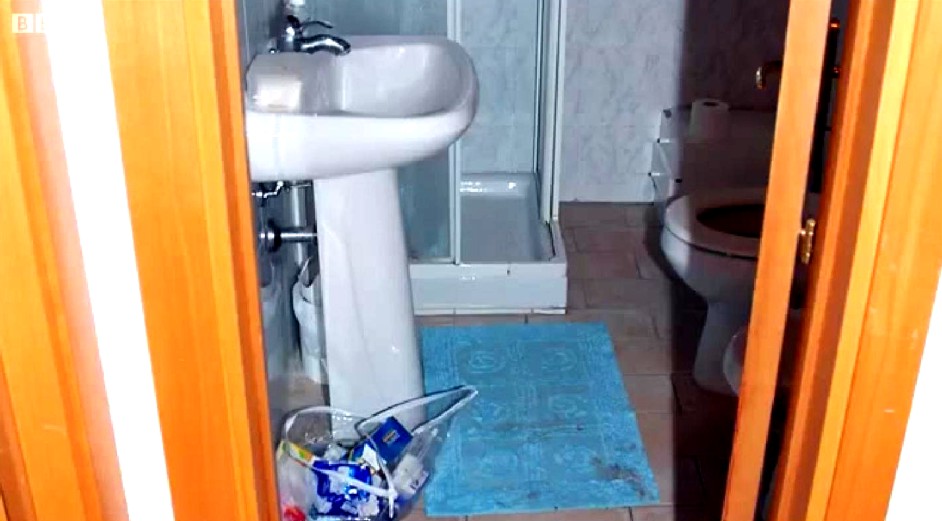
[Please click on each image for a larger and more high-resolution version]
The sheer depth and width of the hard evidence
The defenses really don’t want you to know this: in both width and depth, the full panoply of the evidence against Knox and Sollecito is absolutely overwhelming.
As we remarked in our post below there are far more and far stronger evidence points than UK and US courts normally require for conviction. But only the trial panel of judges observed anything like their full array.
The 2010 Massei Trial Report (which the Nencini Appeal court validated this past January) is a SUMMARY of what was presented to the judges in the courtroom. Those presentations in court were in turn something of a SUMMARY of the hard evidence buried in all the evidence files and the minds of witnesses.
Italian media SUMMARISED for Italians what was to be seen in the courtroom and to be read in the Massei Report. They were barely able to do even summaries for the 1/4 of all the trial hearings that were not open to the media or the public.
UK and US media for the most part didn’t even bother to provide comprehensive summaries (the very fine on-the-spot reportings of Andrea Vogt, Barbie Nadeau and Ann Wise were the main exceptions).
So in effect people in the UK and US attempting to follow the story didnt for the most part receive even a summary of a summary of a summary!
Not one US or UK newspaper or TV network translated the Micheli Report, or the vital Massei Report, or the Supreme Court appeal, or the Supreme Court outcome - only the (mostly professional) translators on PMF dot Org did all that translation.
This post is another example of how far down - beyond even Massei - it’s possible to drill into the evidence, and see it still hold up.
Some past posts on TJMK drilled down to similar depths, on the knives, on the DNA, on the mixed-blood traces, on the phone-events, on the motives and psychologies, and so on. All that evidence too all held up.
Visual analysis of the bathroom-mat footprint
This post mainly consists of high-resolution pictures and measurements. Presented like this, the pictures and measurements largely speak for themselves, and show the real strength of the bathroom-mat footprint evidence.
You will see that as SomeAlibi previously concluded using other methods, this footprint was quite undeniably Sollecito’s. It bears no similarity at all to Rudy Guede’s.
Please click on all images for larger versions in scalable PDF format
1 . [Below] the bathmat and the print, with measurement reference
2 . The bathmat print and the surrounding area
3 . The bathmat print (photo from Polizia Scientifica).
4 . The bathmat print, with vertical and horizontal sizes, from Rinaldi’s report
5. The bathmat print, photo with enhanced contrast.
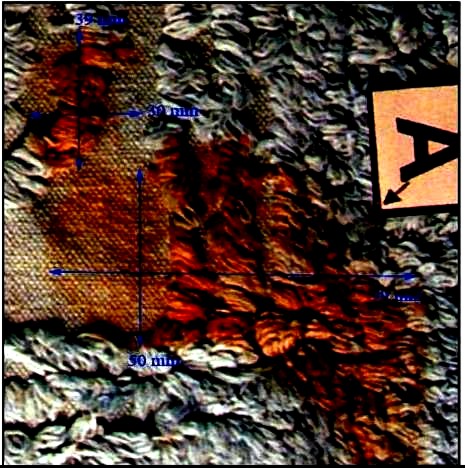
The photo above was modified by highly enhancing contrast.
6 . Enhanced contrast helps to spot some features
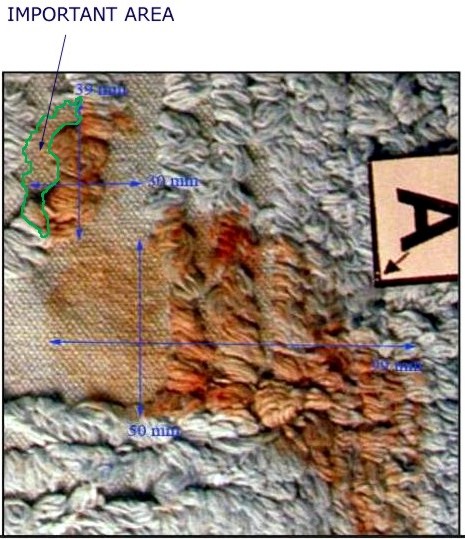
Contrast may help to highlight especially some parts of the print outline.
For example the area on the left labeled as “important area” in the picture (which was “forgotten” in the notorious photo elaborations disseminated by the ‘Friends of Amanda’ group), shows the actual left outline of the “˜big toe’ of the bathmat print.
The toe includes the area indicated in this picture (here the picture is shown again in its original colours).
7. The bathmat, with enhanced contrast
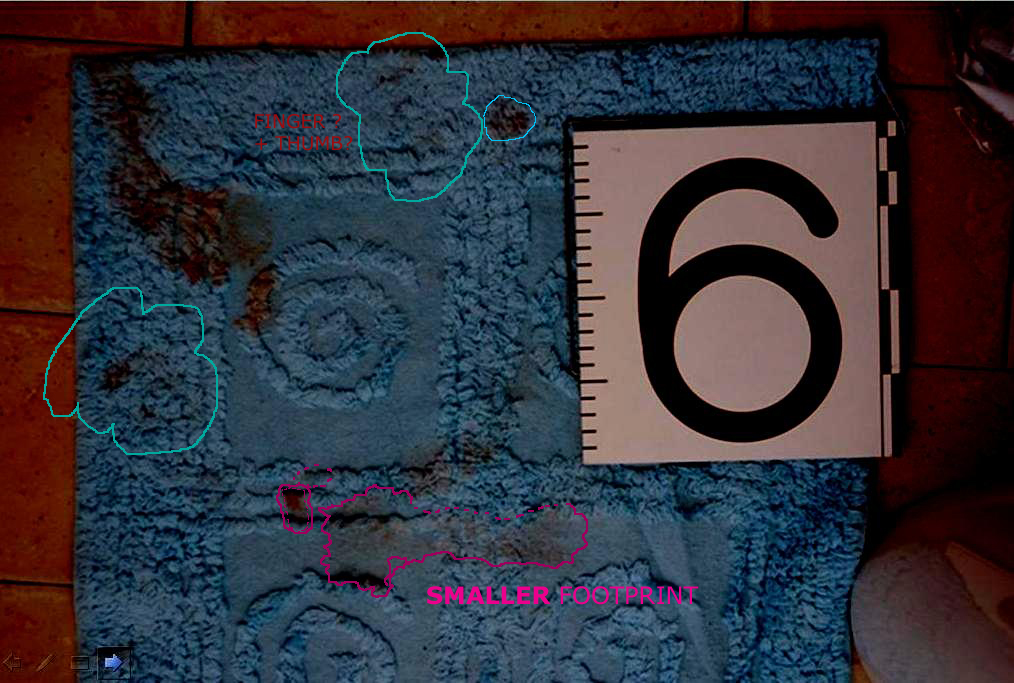
The contrasted image is showing the presence of other stains
There are other stains on the carpet (about another 10, factually situated in one half of the mat area), and also there shows a second diluted footprint (apparently from a foot of smaller size).
8. The selection of a set of red colour shades, outlined by an automatic outline generator
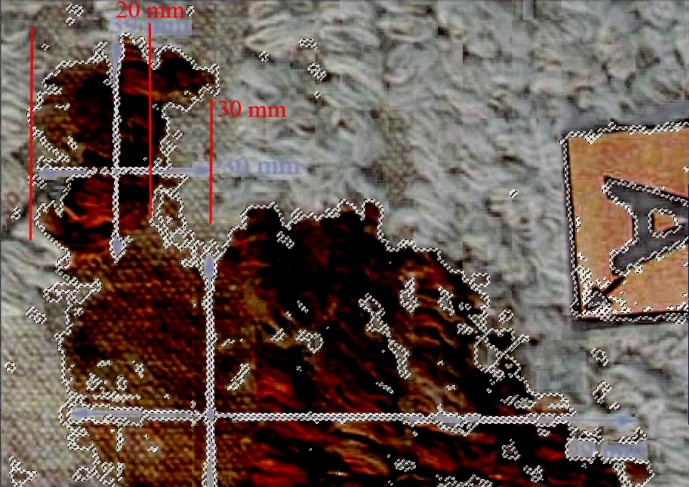
Shows the shape and the possible “˜outline’ of the stain
Reference measurements indicate the width of the “˜big toe’ in millimetres.
9 . A hand drawing of the outline (detail).
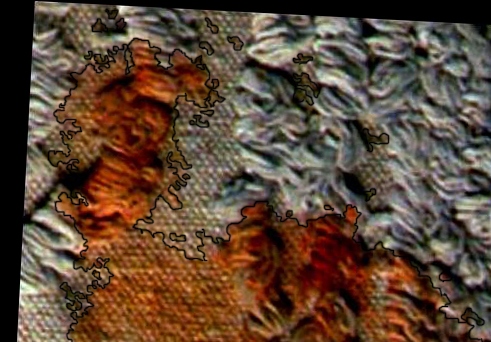
The photography above was modified
The modifications are: +28% contrast, -8% luminosity, + 20% colour saturation, from the original.
An outline has been drawn manually on the photoshop image, trying to be as faithful as possible to the actual stain.
You can notice that, apart from some minor “˜disputable’ very faint areas (such as the area between the toe and the metatarsus) there are only minimal differences between an automatically generated outline and a manually drawn one.
The shapes of the “˜big toe’ are extremely similar in both contours (images 8 and 9), in fact all meaningful features are basically identical.
We consider this manually drawn outline as good for comparison.
10 . The complete hand-drawn outline
11 . Minor detail: small dots separated from the main stain
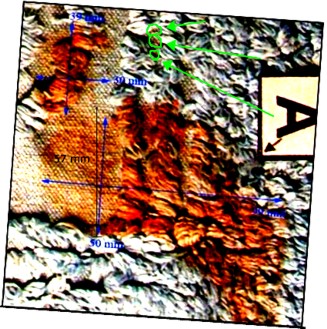
Observe the small red ‘dots’ in the picture above
Although we can’t draw any conclusion about their possible significance, we note the existence of these very small “˜spots’ of a faint red colour shade, separated from the big stain.
They are detected by the computer generated outline above, and that we also see as distinguishable with the naked eye thus we considered them in drawing manually the outline.
We don’t draw any conclusion about them; but because of their sensitive position (they may suggest a “˜small toe’ mark) we take note of them.
The green arrows in the picture point out their position (green circles).
12 . An image in electronically modified colours
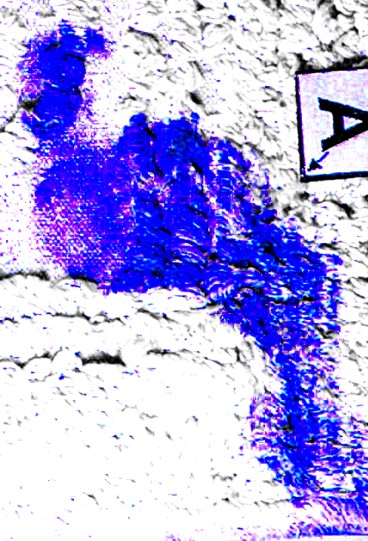
Distribution and intensity of the colouration
As a part of the preliminary study of the stain, we also produced this image above where the computer assigned an artificial colour to an array of shades of ‘red’, thus allowing to further isolate the stain from the background for further assessments about its shape.
This picture shows the distribution and intensity of the colouration. (note: the existence of some above mentioned tiny marks is recorded by this technique too)
13 . The bathmat has a spiral-shaped relief decoration
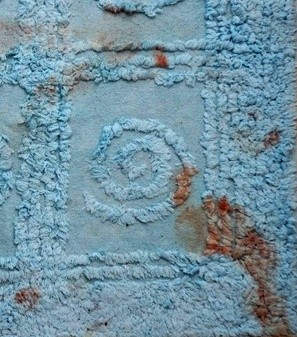
The footprint’s toe obviously balancing on top of the relief decoration.
We think the outline of the “˜toe’ mark of the bloody footprint is affected by the shape of the decoration, in particular the missing part of the toe on the right side, which is remarkably coincident with the margin of the decoration.
So that on that side there is a striking correspondence between the outline of the “˜negative area’ ““ the fabric surface around the spiral, which is lower ““ and the big toe’s outline
This indicates that the outline of that mark on that side was affected by the decoration margin, thus the print there has a “˜missing part’. So the “˜crooked’ bloody area in fact follows the margin of a larger toe.
Because of such coincidence, we can logically assume that the actual shape of the big toe mark appears to be part of a big toe, with larger surface which left its print only partly because part of its surface did not have contact with the fabric, in correspondence of the “˜negative area’.
14. The “negative area”
15. Mat decoration in relief and the toe mark
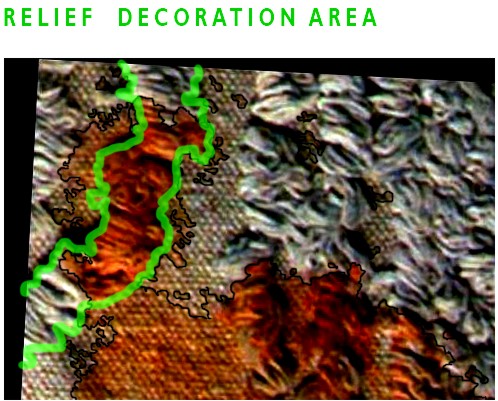
Observe above one single, unitary stain
The remarkable coincidence between the outlines of the decoration in relief and of the toe mark is shown in the picture above.
The rough contour of the print obtained through a smooth curve highlights the shape of the big toe.
Part of the relief decoration outline coincides with the toe mark outline, which shows, highlights and explains how all parts of the red toe mark, that you can see left of the relief decoration, they all belong to one single, unitary stain.
Thus we can deduce that the “missing” area on the right of the toe is determined by the decoration, and coincides with the negative area.
16. Picture (by Kermit) showing a rough shape of the stain
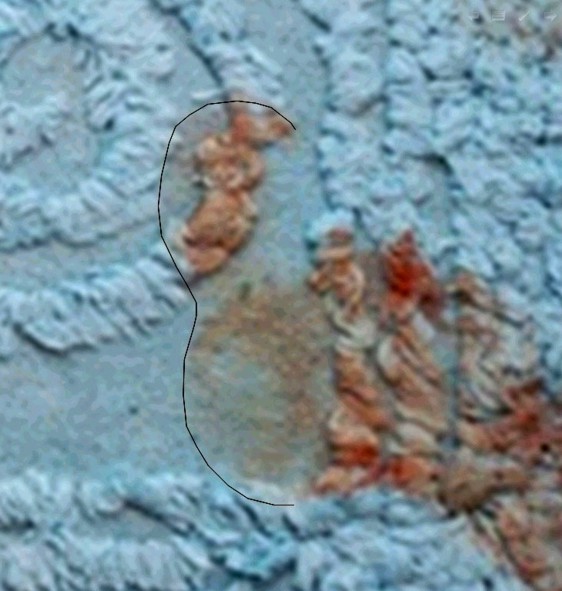
Observe shape, curvature and size
This drawing by Kermit above highlights the rough shape, curvature of left margin and overall size of the big toe.
17. Rudy Guede’s sample print
A copy of this picture together with one of Sollecito’s print at the same scale will be used for comparisons.
18 . Raffaele Sollecito’s sample print
A copy of this picture together with one of Guede’s print at the same scale will be used for comparisons.
19. Part of Rudy Guede’s sample print with Rinaldi’s reference measurements
20. Part of Sollecito’s sample print, with Rinaldi’s reference measurements:
21. Bringing all photographs down to the same scale
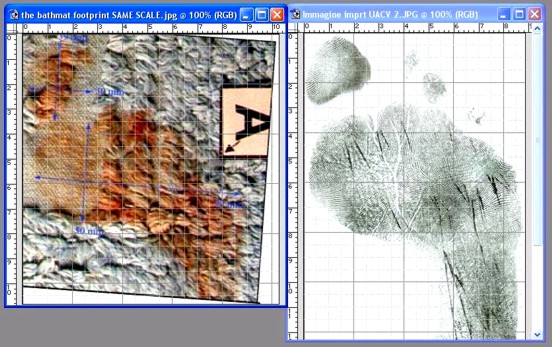
An accurate exercise of scaling was done
This was based on Rinaldi’s referenced pictures. Each one of the Rinaldi’s sample pictures has multiple measurements on several points of reference which allow a high precision determination of their scale and sizes, and thus comparison at the same scale.
In order to further increase scaling precision, the scale was calculated previously and separately for each comparative measurement in the three photos; this was done multiple times for each measurement and the average was picked in order to reduce error as for statistical measurement method.
The resulting final error in the scale is extremely small, far below a threshold of significance that could affect comparison (which was set arbitrarily at 1%, but it’s probably significantly higher, while the actual error is much lower).
In other words, the scale error that may affect your screen pictures will be definitely smaller than any possible perceivable (either significant or tolerated) difference that would be noticed or that may affect the attribution of the stain, when this is compared to the sample.
22. The hand drawn outline is shown again here
23 . The outline (matched scale) overlapped on Sollecito’s sample footprint
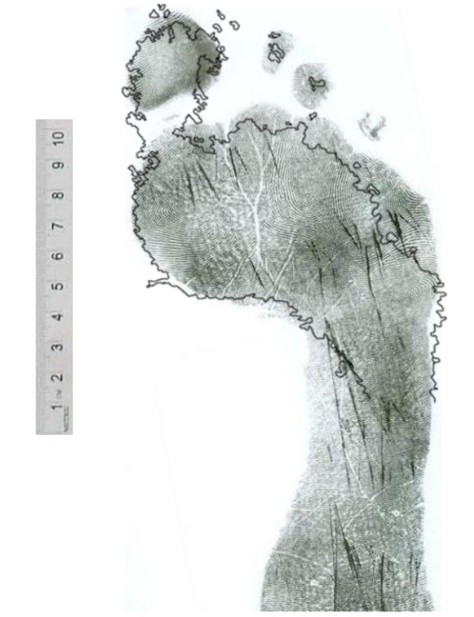
The array of compatibilities with Sollecito
The bathmat stain does not seem to have major incompatibilities with Sollecito’s print; it shows rather an array of compatibilities that can be perceived visually.
One interesting feature is the shape, size and position of a ‘big toe’, that appears as a remarkable coincidence; the toe also has a kind of cleft (see 28 below) on the curvature of its left margin. Another outstanding coincidence is the curvature of the plantar arch on the left.
24 . The same outline overlapped on Guede’s footprint
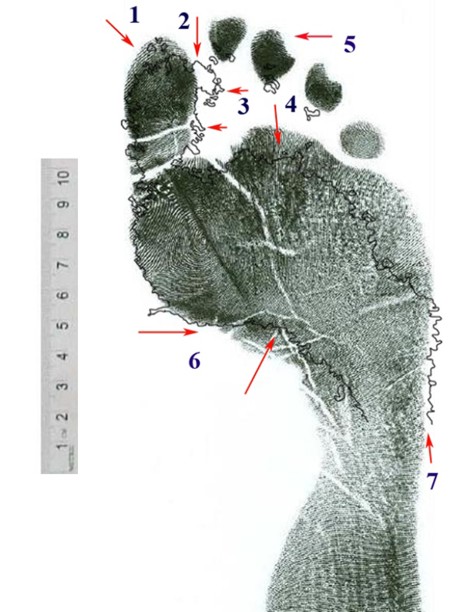
Compare with Guede’s - matched scale.
If you look at the overlapping of the stain outline (see pic 22.) with the sample of Guede’s print (see pics 17. 19.), you may notice 7 major differences, showing a failure of compatibility. Those differences are indicated by numbers (1-7) in the picture .
Each one indicates an area of major difference between the outline of the bathmat stain and the outline of Guede’s sample print. Those measurement differences are remarkably larger than those that can be detected on the overlapping with Sollecito’s sample print.
On the other hand, the compatibility between Sollecito’s print and some very peculiar aspects of the bathmat print (such as a 30mm wide and short toe) were absolutely remarkable.
The differences between the bathmat stain and Guede’s print are :
1) Toe mark of stain is significantly SHORTER than the big toe in Guede’s sample print (a difference of about 7 millimetres). Some people may want to attempt an objection, by suggesting that such a difference may be just a consequence of the position chosen for the overlapping, that maybe the bathmat print was just positioned too low in the picture, the problem may be solved by shifting it up about 7 millimeters so as to make the tip of the bathmat toe ‘coincide’ with the tip of Guede’s print toe.
However, such objection wouldn’t work; it’s a wrong argument. In fact the only possibly correct position for overlapping the bathmat stain outline is determined by the left curvature of the ball of feet and plantar arch (the area of the picture near number 6), which is by the way the most clearly outlined part of the bathmat stain. If you shift the bathmat stain upwards, the outline will miss the match with the curvature of the left margin of the ball of the feet. You will notice that the plantar arch in this area is already very incompatible with Guede’s plantar arch. It tends to become even more incompatible the more you shift the bathmat stain outline towards the toe.
The problem has no solution, since the more you shift the stain outline upwards (in the direction of the toe) in an attempt to make it look more ‘compatible’ with the length of Guede’s toe (or with an upper margin) the more it will become incompatible with the plantar arch. In order to limit the incompatibility of the plantar arch, and in order to keep an overlapping of at least the left margin of the ball of the feet, you need to place it as shown in the picture, this is the position of ‘maximum’ compatibility between the bathmat stain and Guede’s print. Conclusion: the bathmat toe is too short.
2) Toe mark of stain is TOO WIDE (30 mm). It is much wider (30 mm) than Guede’s toe. The number 2. indicates the protruding mark at the upper right, the mark which Giulia Bongiorno desperately insisted on calling a “second toe” mark. In fact, not only would the mark miss completely any hypothetical Guede’s ‘second toe’ in any possible position of the print; also you may notice (highlighted by pics 8. and 9.) how it is not a “mark” itself, but actually it just part of the same area which is entirely continuous in shape and coloration with the rest of the toe mark, and - the most remarkable feature - its right outline is coincident with the outline of the spiral-shaped relief decoration, so that you can reasonably conclude that it is determined by that (the missing area at the lower right of the ‘big toe’ is determined by the existence of the “negative area” of the bathmat decoration).
Conclusion: the bathmat stain has a wider toe mark, however one likes to call it (“big toe”, or “big toe + second toe”) that fails to match any possible part of Guede’s print. The bathmat print is clearly different and incompatible with Guede’s print. It simply cannot be overlapped to any part of Guede’s sample print. Such area is a very significant difference that points outright to incompatibility between the stain and Guede’s print.
3) The toe mark is larger also in the area located at the lower portion of the toe. The toe of the bathmat print in fact has a ‘right margin’ which actually has some additional small marks, small drops protruding towards the right, like droplets maybe produced by the wet cotton fibres of the part in relief which protrude towards the right. This tends to suggest the toe area of the stain may in fact be considered wider: the object that produced it was definitely wider than 22mm, in this area of the toe as well. So also a look at this area confirms that the bathmat stain is wider than 22-23 mm (more towards 30 mm) not just when measured at the upper corner (number 2.) but also at its “lower” parts; here, the small marks caused by the liquid suggest that a larger surface has squeezed liquid from some fabric threads leaving some trace also on the lower area.
4) Bigger incompatibility of Guede on the metatarsus front outline. This area is the front outline of metatarsus: the stain is almost 1cm shorter than Guede’s metatarsus. This happens when you chose the overlapping so as to make the left outline and plantar arch (6.) of metatarsus coincide, as in the picture. Sollecito’s sample print also shows some difference from the stain in this area (pic. 23.) but the difference between the stain and Sollecito’s print is significantly smaller than what you can see in Guede’s print.
5) There are NO SMALL TOES in the bathmat stain. Small toes are completely absent from the bathmat stain (while the tiny blood marks around the stain don’t coincide with their expected position if it was Guede’s print). Such lack of small toes is a peculiarity of the bathmat print. This is a remarkable difference from Guede’s print, and at the same time, a considerable analogy with Sollecito’s print. In fact one outstanding feature of Guede’s print is the evidence that Guede places a big load of weight on his small toes while instead Sollecito has a posture with a weight distribution with the contrary tendency, and obviously he almost does not touch the ground with his small toes.
Thus, Guede’s small toes are all very well pressed on the ground and thus, we can reasonably infer they are somehow naturally likely to get wet if he steps on any wet surface, and anyway they should get wet for sure if the foot is immersed in water or washed (the foot that left the bathmat print must have been immersed in bloody water). The murderer supposedly washed his foot then stepped on the bathmat. In order to attribute the print to Guede we should assume that Guede “forgot” to touch the carpet with his small toes (while instead he puts a lot of weight on them) or that he managed to not rinse them.
6) The outline of the stain has a PLANTAR ARCH that COINCIDES, by curvature and angle, with the plantar arch in Sollecito’s print, while instead it is very different from the plantar arch of Guede’s print.
7) The stain is larger than Guede’s print metatarsus as visible in the right area of the stain. The difference is rather significant, almost half a centimetre, that is bigger than the difference with Sollecito’s print which instead coincides for a trait. This difference cannot be “solved” in any way since, even if one wanted to claim that the scale is wrong and that the stain should be sized down, this would make the toe, already too short (as in 1.) become even shorter.
If instead the toe length is adjusted the metatarsus becomes even less compatible with Guede. We recall that Massei found that Guede’s feet had a print overall more slender than Sollecito’s.
25 . Other features:
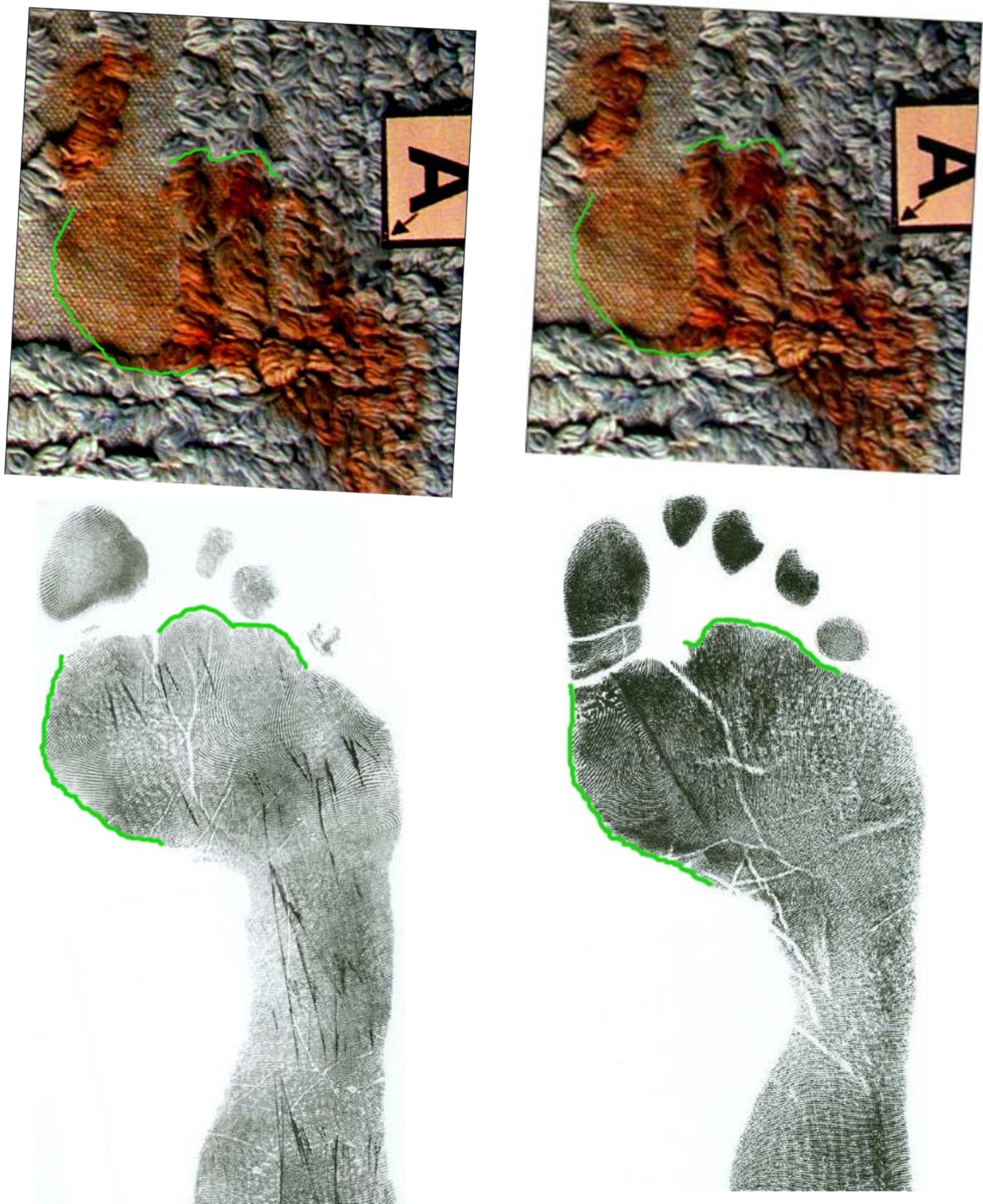
Curvatures of plantar arch are very different
The plantar arch curvature, highlighted in two different drawings (the second highlights also the upper outline “hunches”); the plantar arches in the two sample prints of Sollecito and Guede are shown below. The curvatures of plantar arch are very different.
26. The outline curvature generates different angles
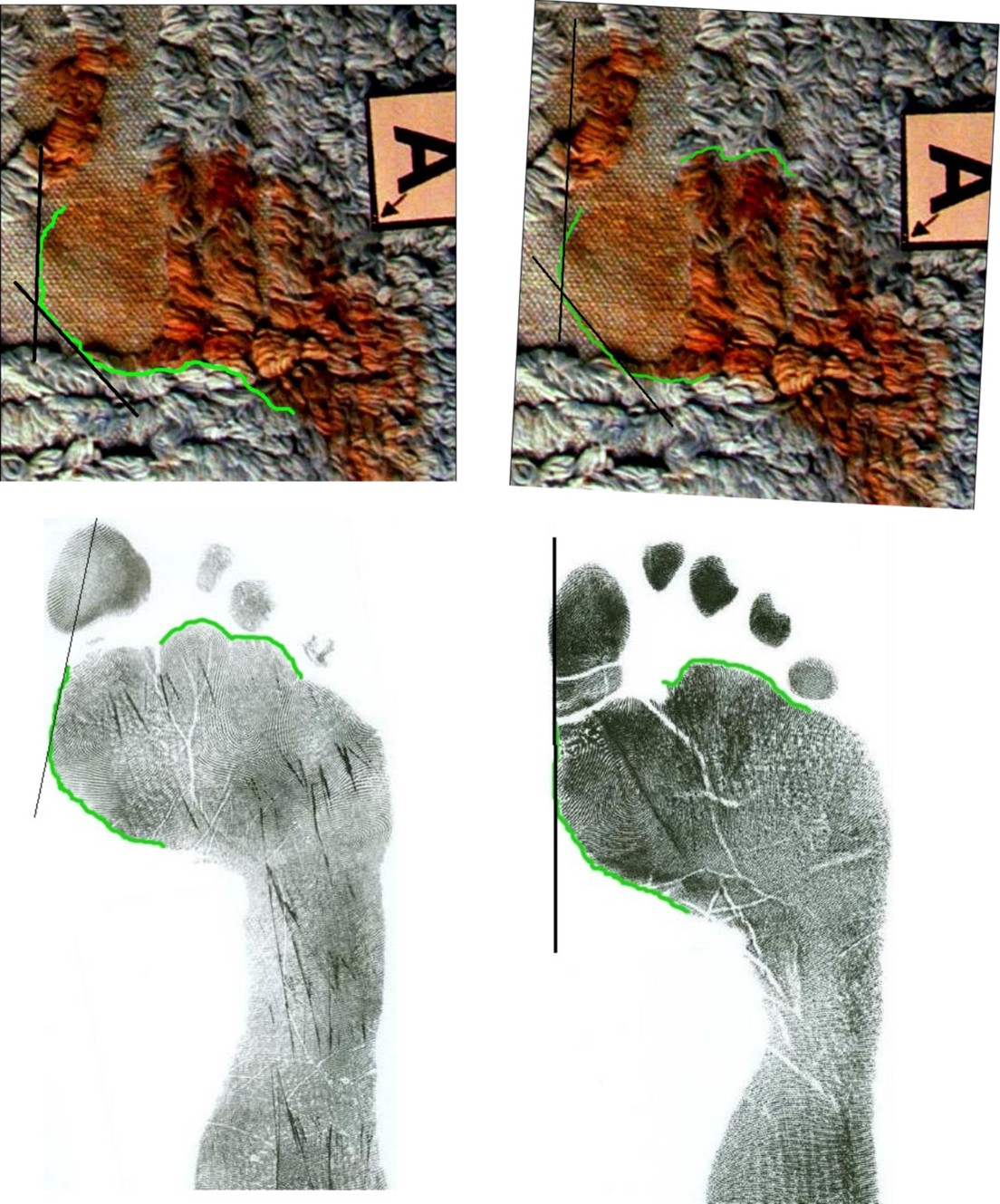
Sollecito’s and Guede’s plantar arch curvatures have very different angles. Also the left outline of metatarsus maintains a different curvature. Sollecito’s outline has an angle (see outline tangent) intersecting the toe (the metatarsus has a “bunion”); in Guede’s print there is basically no intersection, the outline and the toe form almost a straight line.
27 . Plantar arch curvature angle differs between Sollecito and Guede
If you consider the vertical axis of the sample footprint, and its orthogonal line, you may notice how the plantar arch curvatures of the two prints accomplish different angles: the two angles are VERY different, not just three or four degrees.
The (too) narrow angle of Sollecito’s plantar arch probably has a relation with the protruding outline and angle seen in pic 26., and seems related to a hallux valgus (which Guede does not have).
28 . The “cleft” on the left side of the stain
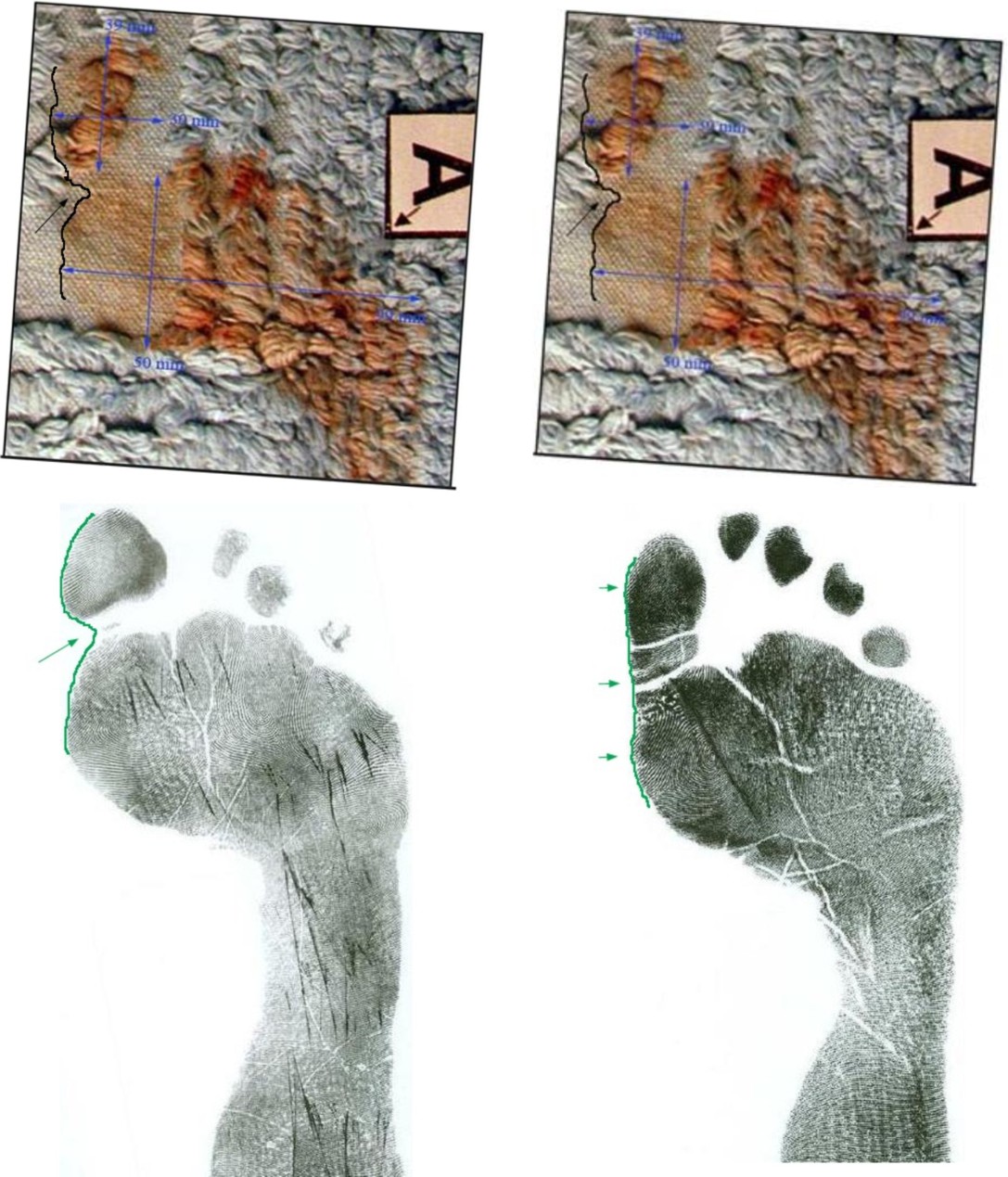
The “cleft” on the left side
This has a correspondence with one sample print, not so with the other.
29 . Table of metric comparison (by SomeAlibi)
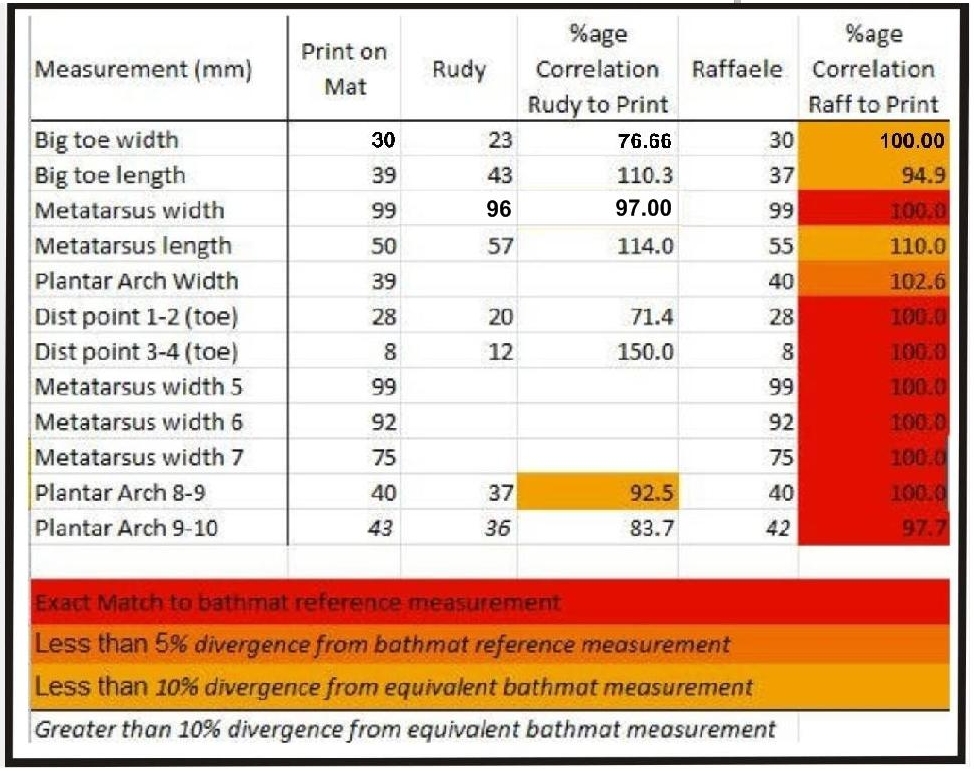
SomeAlibi’s post of a year ago
Comparison of measurements and analysis of correspondence degree of bathmat print, with both Guede’s and Sollecito’s sample prints.
Monday, March 03, 2014
As Knox & Sollecito Try To Separate Themselves, Each Is Digging The Other In Deeper
Posted by willsavive
1. Sollecito Blabs Yet Again
One of an increasingly long list of “gotchas” for the prosecution, flowing from their tendencies to talk way, way too much.
In a recent exclusive interview on an Italian TV news broadcast, Sollecito said he has several “unanswered questions” for his former girlfriend, Amanda Knox.
“You all know that the focus was only through Amanda to her behavior, to her peculiar behaviour, but whatever it is, I’m not guilty for it. “Why do they convict me? Why do put me on the corner and say that I’m guilty just because in their minds I have to be guilty because I was her boyfriend. It doesn’t make any sense to me.”
This adds yet another waiver to the many different explanations Sollecito provided over the years about the same details.
In their “official” story, in the part that remained consistent, Knox and Sollecito both claimed that Knox left his flat the morning after Kercher’s murder and returned home, where she noticed the door left wide open and witnessed blood spots in the bathroom.
Knox claimed that she found it odd and just assumed that one of her roommates was menstruating and left blood behind. She proceeded to take a shower and returned to Sollecito’s flat and ate breakfast.
2. Telling Narrative Change
“Certainly I asked her questions,” Sollecito explained in his latest interview. “Why did she take a shower? Why did she spend so much time there?” When asked what responses he had for these question Sollecito replied, “I don’t have answers.”
In the interview, Sollecito said Knox left his apartment to take a shower, then returned hours later looking “very agitated.”
Yet, in an interview with Kate Mansey on 4 November 2007 just two days after the murder, and two days prior to arrest, Sollecito said:
But when she went into the bathroom she saw spots of blood all over the bath and sink. That’s when she started getting really afraid and ran back to my place because she didn’t want to go into the house alone.
3. RS Differs Sharply From Knox
This is a far cry from what Knox said in her email also dated 4 November 2007 to friends and family, Knox wrote:
I returned to raffael’s place. after we had used the mop to clean up the kitchen i told raffael about what i had seen in the house over breakfast. the strange blood in the bathroom, the door wide open, the shit left in the toilet. he suggested i call one of my roommates, so I called filomena.” (6th paragraph).
The discrepancies between Knox’s version and Sollecito’s version is strikingly different.
- Raffele claims Knox was visibly distraught when she returned and that this was the focus of discussion (i.e. being the first thing they discussed).
- Knox claims that she did not even bring up the bizarre circumstances back at her apartment until “after” they finished mopping the kitchen floor.
4. My Analysis Of The Above
In his latest statement, Sollecito is clearly trying to distance himself from Knox, believing that there is far more evidence against her than against him. But:
- Sollecito forgets to mention the bloody barefoot prints at Knox’s apartment, found to be in Kercher’s blood attributed to him.
- Also the knife found in his apartment that scientists say was the murder weapon.
- Also his DNA found on Meredith Kercher’s bra that was found in her room, even though Sollecito claims that he was never ever in that room.
- Also his own strange behavior, which includes providing a false alibi (saying he and Knox were at a party with a friend on the night of the murder).
Also several conflicting other versions.
But what’s there to question if you [Raffaele] were with Knox the whole day and night of Meredith Kercher’s murder?
It appears as though Sollecito is alluding to the notion that he knows something far more than he is saying; yet, he is being very careful with his words””only providing us with a hint of this.
His latest statement is a clear attempt to distance himself from Knox.
5. Sollecito Freaks Out On Twitter
Sollecito appeared on Twitter recently, for what he claimed was to answer questions and clear his name.
He was very outspoken of his innocence and had no problem in his witty, sarcastic responses to those who questioned his innocence.
However, when I asked him about the Mansey interview he denied claiming that he was with Knox at a friend’s party on the night of the murder [huh?!].
Sollecito disappeared for a couple of days, came back to Twitter writing only in Italian, and ceased responding to any more questions.
Is it possible that Sollecito will turn on Knox altogether at some point when the pressure mounts over the next year? Guess we’ll have to wait and see”¦
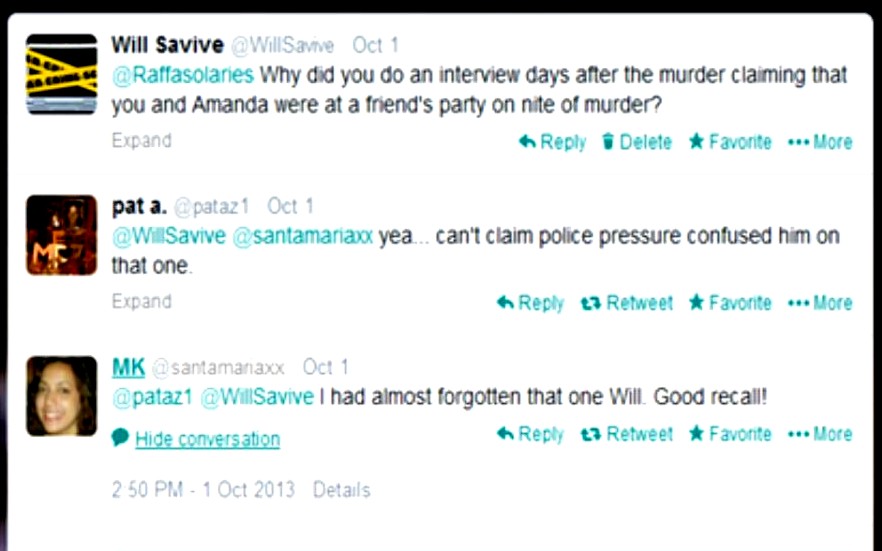
Cross-posted from Savive’s Corner
Friday, February 14, 2014
Hard Questions By Italian Journalist Giuseppe Castellini For Sollecito
Posted by Peter Quennell
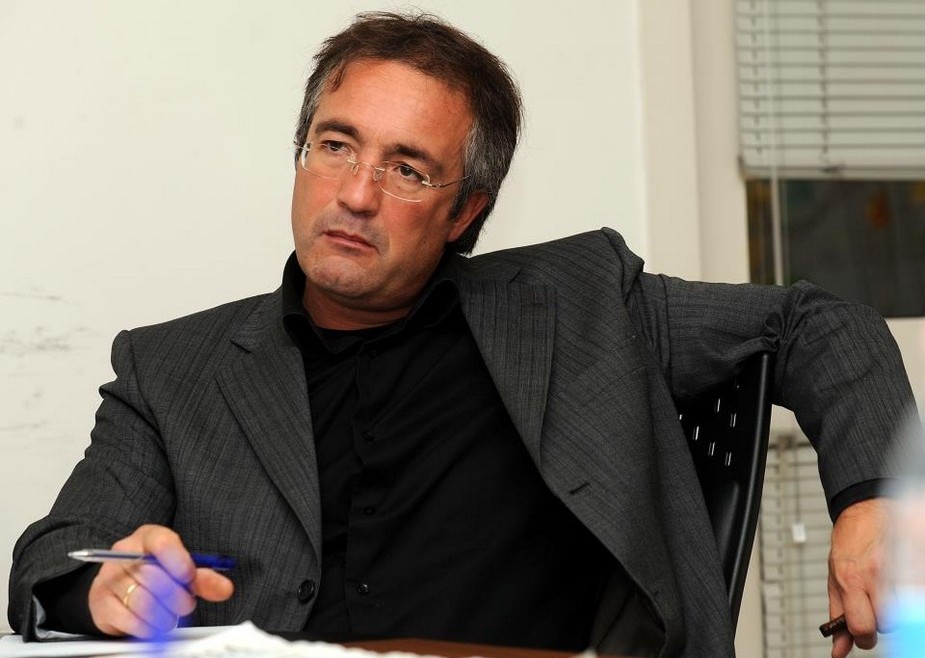
[Above: Giuseppe Castellini of Giornale dell Umbria has long exposed the Knox/Sollecito lies]
1. Overview Of Italian Media Takes
The fast-growing satires of Knox and Sollecito in Italy described in our previous post are not just emerging in a vacuum.
The many tough crime-show comperes and crime reporters in Italy have rarely let Knox or Sollecito get away with any of their lies. One example was when Bruno Vespa, the host of Porta a Porta, Italy’s most popular crime show, forced Francesco Sollecito to admit to Italy that his son lied extensively in Honor Bound. Another example is when Oggi published some of Knox’s lies and they were rapidly exposed. For seemingly endorsing Knox’s lies Oggi will face trial for obstruction of justice.
There are countless other examples where Sollecito and Knox have been exposed as liars. The super-sharp editor of the Giornale dell Umbria, Giuseppe Castellini, has just published this challenge to Sollecito who had absurdly had claimed that nobody ever wanted to ask him any questions in court.
2. Giuseppe Castellini Questions RS
The translation is by Miriam.
Murder of Meredith: a few questions for Raffaele Sollecito
Raffaele Sollecito, found guilty and condemned to 25 years by the Appeals Court of Florence, for the murder of the English student Meredith Kercher (for the same crime Amanda Knox was also found guilty and Rudy Guede is already serving a definite sentence of 16 years) has stated that he was never questioned in court, because no one ever asked him.
For the record and in order to have a complete picture at, it should be remembered that during the investigation, Sollecito twice took advantage of his right to not respond to the questions of the PM Mignini.
So if it’s true that the prosecutors, in all the trials never asked to question him in court, neither did he ask to be, limiting himself to giving several times making spontaneous statements, without being cross examined.
However, this is not the real point. The fact is that Raffaele could not or did not want to respond to the questions of the investigators.
His version was always brought forth in detail by his lawyers, obviously, but that is not the same thing.
Important questions remain to which Raffaele did not answer directly during cross examination by the Prosecutors. Let’s try to summarize some crucial unanswered ones. Who knows if Raffaele will ever decide to respond in detail right here on these pages even though ““ at the moment ““ it seems improbable. We address him directly, sure that he reads these pages.
1. The first time that you were questioned in Questura you said that the first of November 2007 (Meredith was murdered the night between the first and the second of November) after a walk through downtown Perugia (before that you and Amanda have been in the house in via della Pergola). You came home around 08.00pm while Amanda come back much later around 01.00am, you then changed your version saying that you had always been together. Your first statement seem like a distancing from Amanda, in those hours nobody knows what she did, while the second one has a complete different flavor. Why did you radically changed your version?
2. It’s proved by the findings (even if your lawyers contested it) that the computer in your house was activated for about half an hour from 05.32am till little after 06.00am of the second of November. For the experts of the Police it was certainly a human interaction. You, instead declare that you and Amanda were sleeping. So who was it then that was using your PC at that hour?
3. Your and Amanda’s cell phones were turned off at the same time around 08.40pm of the first of November and they were turned on, practically at the same time, a little after 06.00am of the second of November (at that time you received the “good night” sms sent from your father the night before). How do you explain all this?
4. You stated that you were not in the house in via della Pergola. How it is possible that your DNA is on the bra clasp (17 loci that shows your genetic profile, and for the father of Italian genetics, Prof. Vescovi, that with the current processes are not only enough, but more than enough to match your DNA). And why did luminol revealed a bare right foot print compatible with yours, in addition to the one on the bathmat in the small bathroom? (the size of the big toe, just to point out one thing, is just like yours, while Rudy’s is a lot smaller).
5. Why, if Rudy was the only assassin, in the corridor would he cancel only the bare foot prints, leaving in plain sight always his, but left with the shoe print of his left foot? Doesn’t it come to mind that whoever cleaned up the prints thought to cancel theirs (specifically the ones ascribed to you and Amanda) leaving behind those recognizable as Rudy’s?
6. You and Amanda were seen by the homeless Antonio Curatolo late the night of the murder and Amanda was seen by the shopkeeper ““ that knew you well and already saw you with Amanda ““ enter in the shop at about 07.45am to buy something and go back toward piazza Grimana. You and Amanda say that at that hour you were sleeping in your house. Is there something that can demonstrate this, that up to now has slipped away and that would give you the missing alibi?
3. Questions For RS Of Our Own
We have advanced plenty of questions for the evasive Sollecito of our own. Here are seven examples.
- Questions For Sollecito Do You Stand By Your Smear Of Reasonable Doubt In Italian Law?
- Questions For Sollecito Why Claim Guede Did It Alone When Vast Evidence Contradicts That?
- Questions For Sollecito Why So Many Contradictory Explanations Of How DNA Got On The Knife?
- Questions For Sollecito Did Your Father & Lawyers Pre-Approve This Crazed Rant?
- Questions For Sollecito Can You Realistically Account For The Hard Evidence On The Bathroom Mat?
- Questions For Sollecito Katie Couric, Push Back Against Sollecito’s Bluster And False Facts #2
- Questions For Sollecito Katie Couric, Push Back Against Sollecito’s Bluster And False Facts #1
Monday, February 03, 2014
Guide For Smart Media: Note Extensive Hard Evidence In Exceptionally Fair, Careful Legal Process
Posted by Media Watcher
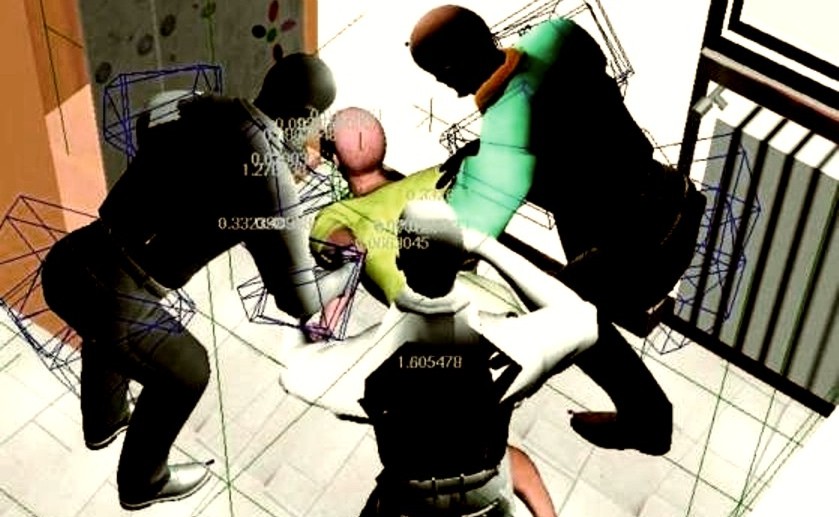
[Accurate Italian media recreation of attack based on masses of closed court evidence 2009]
Vital media history in 2009
In Italy and Europe generally the guilt of the two is almost universally perceived.
One reason is that although about 1/4 of the trial in 2009 was behind closed doors (quite the opposite of the “tabloid storm” and “show trial” Americans have been told about) Italians in particular got to find out about the long (15 minutes), remorseless, highly sadistic attack on Meredith.
Please click here for more
Wednesday, January 29, 2014
Continuing Enormous Strength Of The Evidence Which Defenses Seem To Have Abysmally Failed To Shake
Posted by Our Main Posters
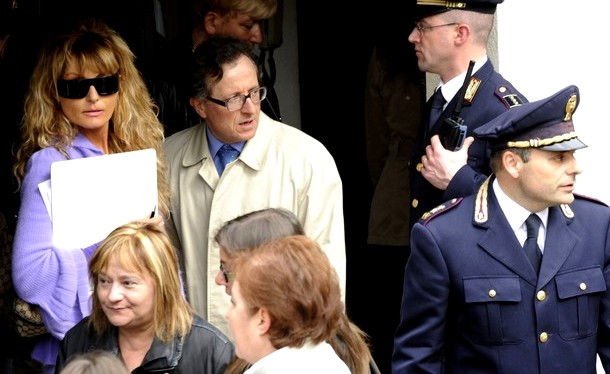
[Above Judge Massei at Meredith’s house with panel-of-judges members early 2009]
What this Florence appeal is REALLY about
There is much confusion on this, sowed by various at-distance commentators who don’t read the Italian press or the excellent English-language reporters right there on the spot.
This is NOT a re-trial. This is a FIRST appeal by Sollecito and Knox against the guilty verdicts and sentences Judge Massei awarded them late in 2009. It is being repeated since their defense teams helped to bend the first (Hellmann court) iteration of the first appeal two years ago.
Since the end of 2009 they have been provisionally guilty of murder and other crimes, subject to final ratification by the Supreme Court, which has not yet occurred. Judge Hellmann decided to let them out and travel worldwide. Many think his decision on this was legally weak.
Was there prime-face justification for this appeal?
Under US and UK law many lawyers and judges think the judicial process could have stopped right there in the US and UK, because the grounds for appeal the defenses came up with in 2010 were essentially innuendo about DNA and little else.
But the pro-defendant Italian system unlike almost any other in the world allows appeals if any are filed to automatically go forward. So the bent, stretched-out and illegally wide-scope Hellmann appeal of 2011 was the first result.
Appointed apparently in illegal circumstances to replace the highly-qualified Judge Chiari (the lead-judge for criminal appeals, who then resigned) Judge Hellmann was ill-qualified at best - he was not a criminal judge and had handled only one other murder trial before, which he got wrong.
The annulment of the first first-appeal
The Supreme Court very rarely completely annuls any trial or appeal. But in this case in March 2013 it did just that, on a large number of grounds.
The 2013-2014 Nencini appeal court in Florence starts with the early-2010 Massei report plus new guidelines from the Supreme Court. Nothing else floated since early 2010 counts.
This case seems to break all records ever for (1) defamatory and dishonest PR; (2) dirty tricks, many illegal, by the defense; (3) dishonesty by those accused in two defamatory books and multiple statements to the press; and (4) greed and blood money while the process still goes on.
Contempt of court trials and investigations have commenced to push back, Amanda Knox is particularly at risk because her book contains false accusations of crimes (again) and she defies the Supreme Court in not paying Mr Lumumba his damages though she destroyed his business.
Suggested Reading: Part One
Sooner or later (no necessarily now) read all the must-read posts in this group here, all the open questions for Sollecito in this group here, and all the open questions for Amanda Knox in this group here.
1. Getting up to speed on the 2008 RS and AK charges
Our four-part summary of Judge Micheli’s report is the best thing to read (scroll down) especially Micheli’s argument that ONLY Knox had any reason to re-arrange the crime scene - she lived there and needed to point evidence away from herself.
Also read Amanda Knox’s and Raffaele Sollecito’s many mutually contradictory attempts to provide one alibi for both.
2. Getting up to speed on the 2009 RS and AK trial
The prosecution performed brilliantly and left the defenses despondent and out-classed (paving the way for more dirty tricks in 2010-13) and we were told that two defense lawyers nearly walked off.
To get a flavor of how badly the defenses did, read this post and this post on Knox’s absolutely disastrous stint on the stand. From there the defense portion of the trial really went downhill.
To get a flavor of how well the prosecution did read about the damning reconstruction (known about in all of Italy but not widely elsewhere) described here and here.
3. Getting up to speed on the Massei 2010 Report
The most vital read of all is the short-form version of the Massei Report by Skeptical Bystander and a team on PMF dot Org. If you have no time to read any posts, make sure to read that.
The other vital reads, not here but on the new “The Murder Of Meredith Kercher Wiki”, are the overview of the evidence and the chart of evidence synopsis.
We had a large number of posts starting in 2010 checking out whether in all details the Massei Report got it right. Read this first take.
4. Getting up to speed on the crime-scene scenario
Vital to understanding the Massei court’s crime-scene scenario which Prosecutor Crini espouses, wade through this excellent reconstruction of the crime in a long Powerpoint by our lawyer James Raper with the Powerpoint whizz Kermit.
About Part Two
The next part of our most-recommended reading from 2010 to 2014 will follow after the verdict to help correct the ill-informed debate over whether Knox goes back to jail.
It hardens the case and in our view leaves no holes for RS and AK to wiggle through. We will point the post to those arguments that anyone tries to raise.

